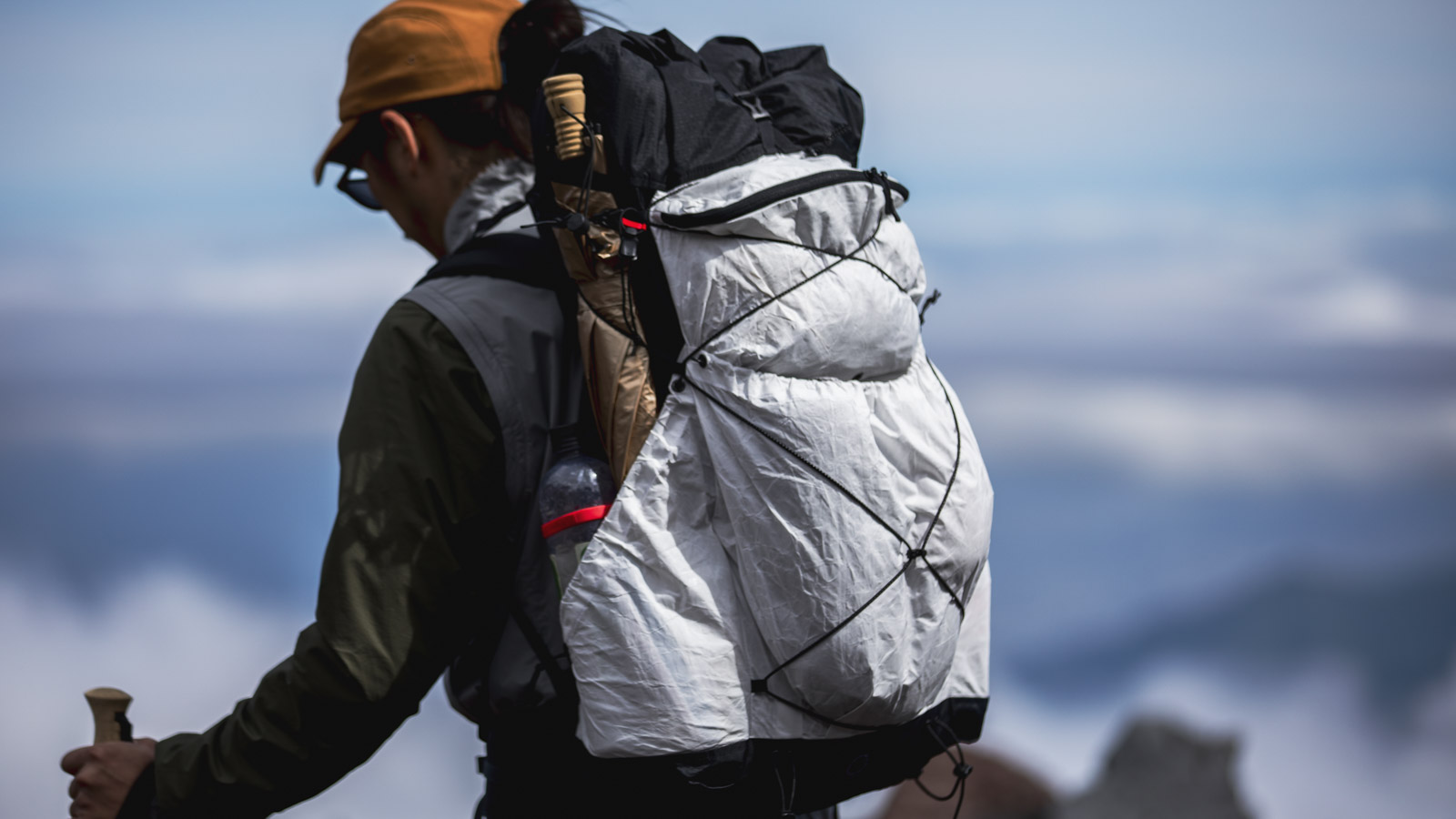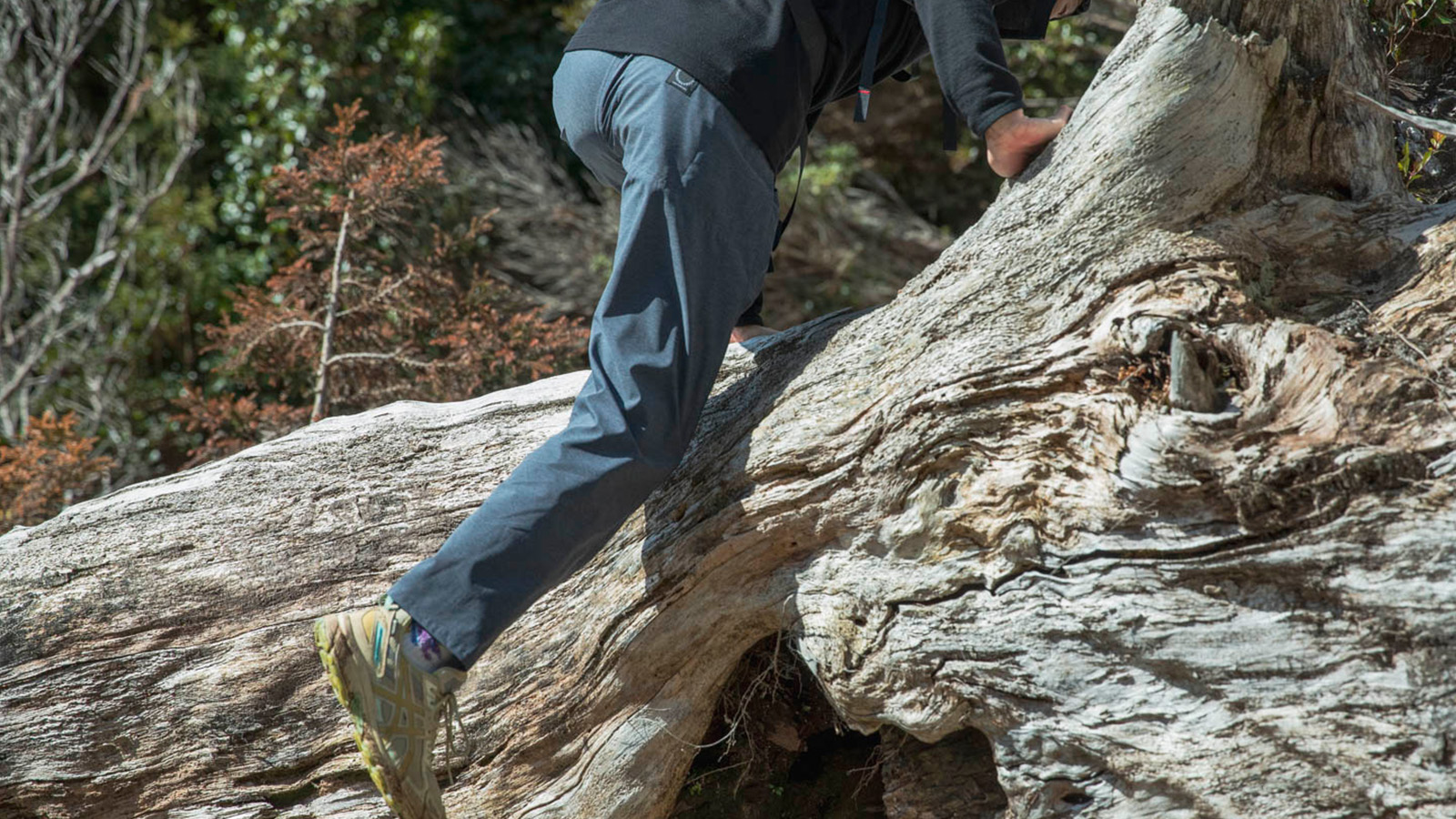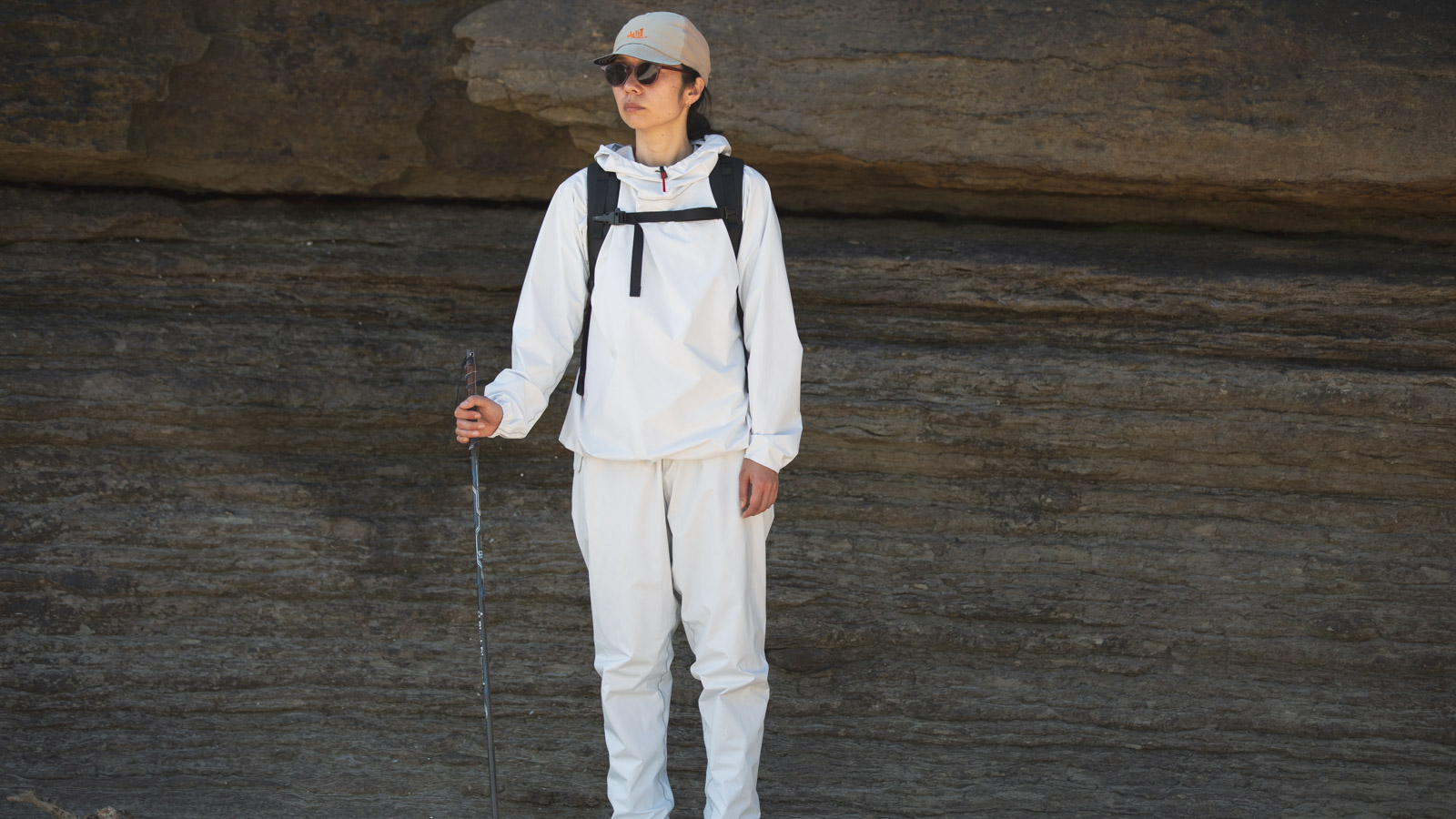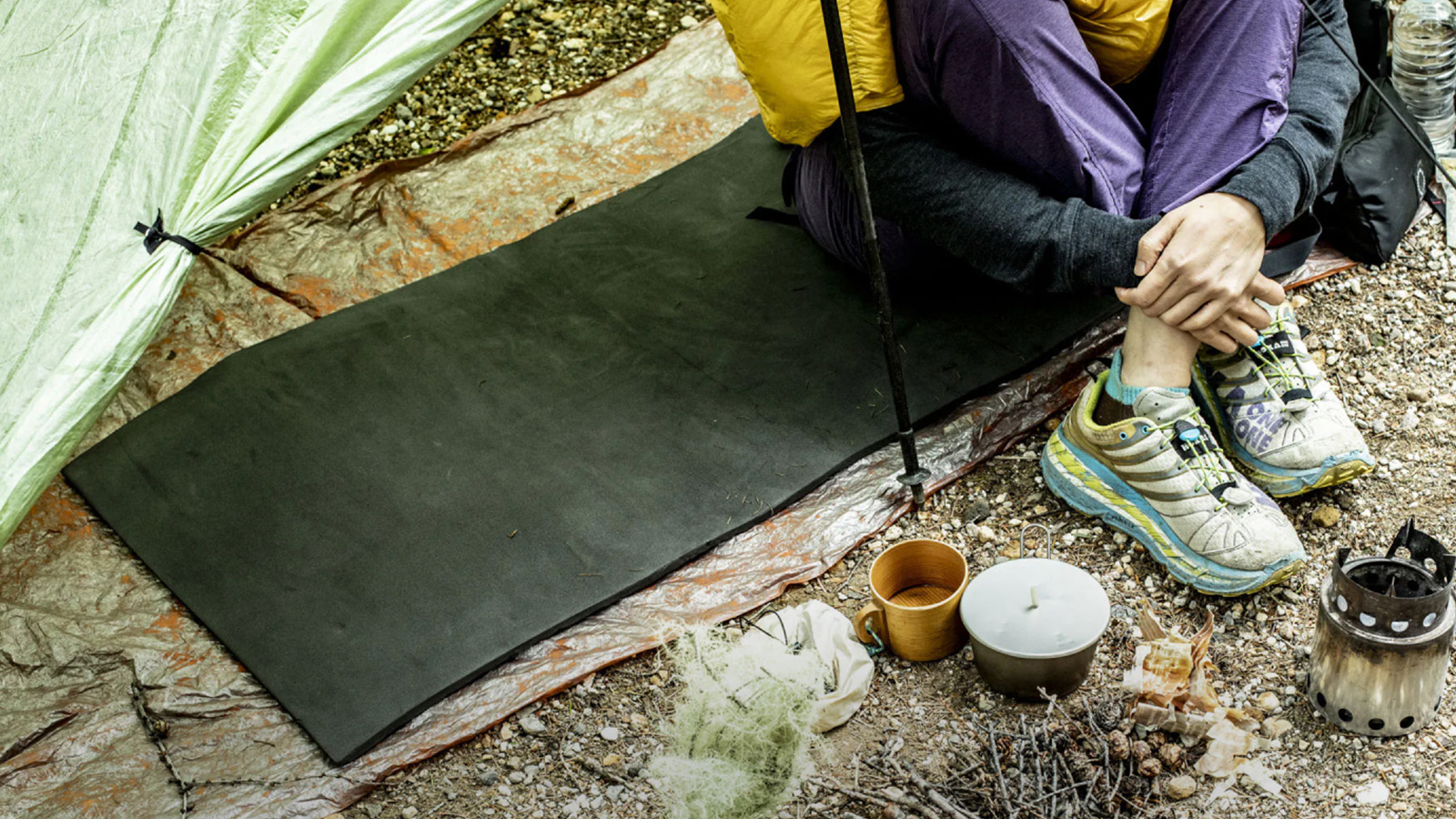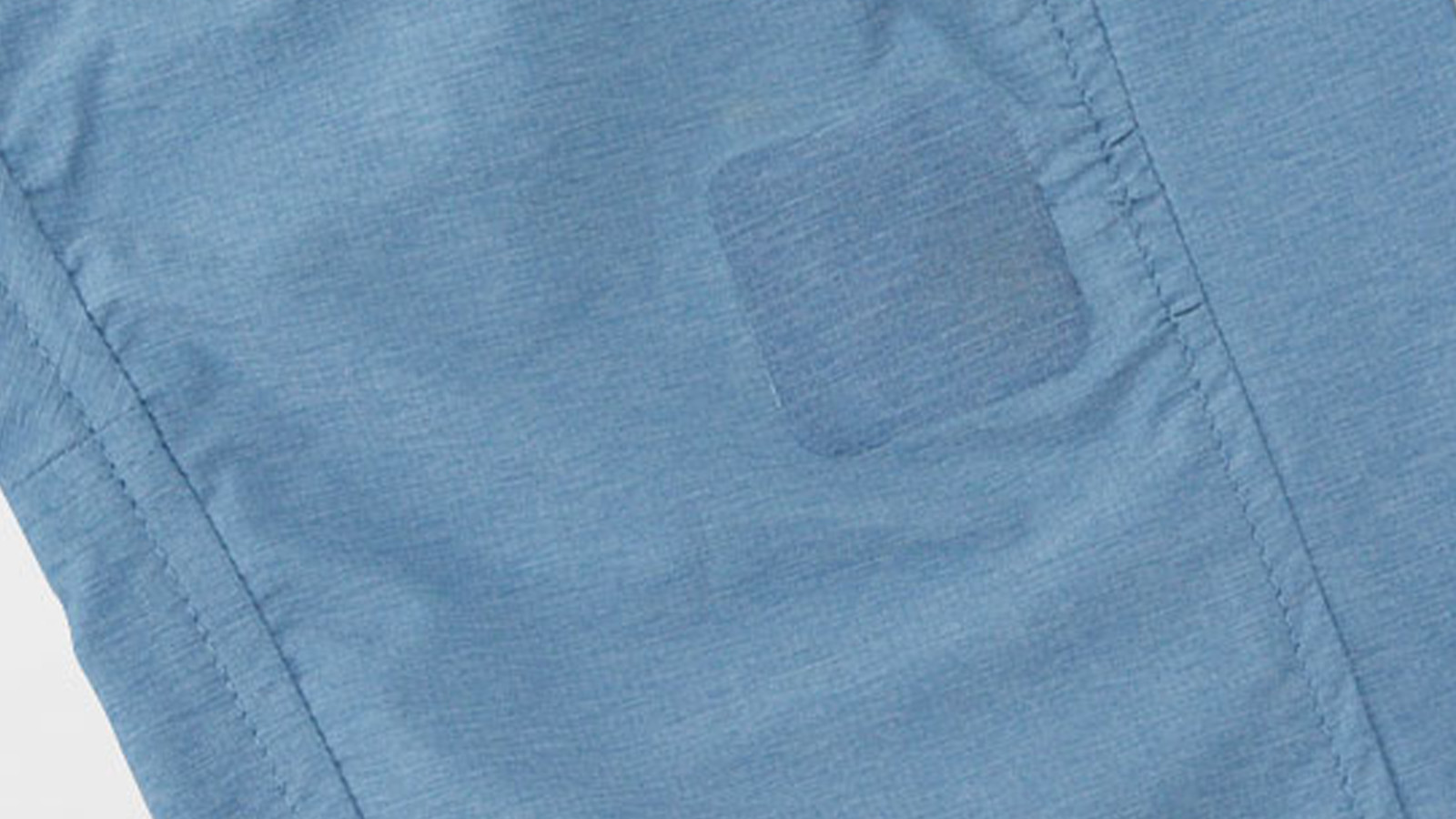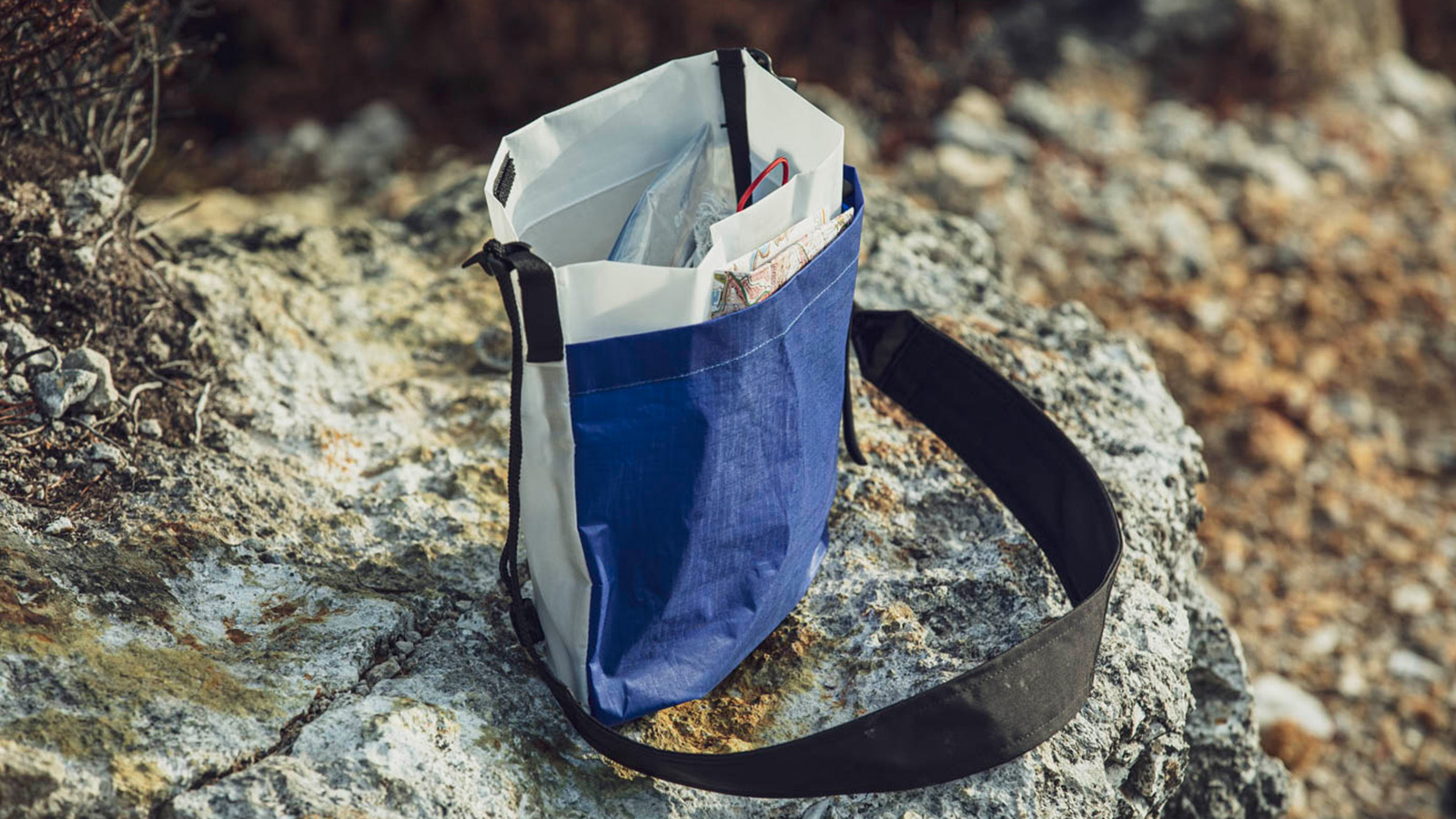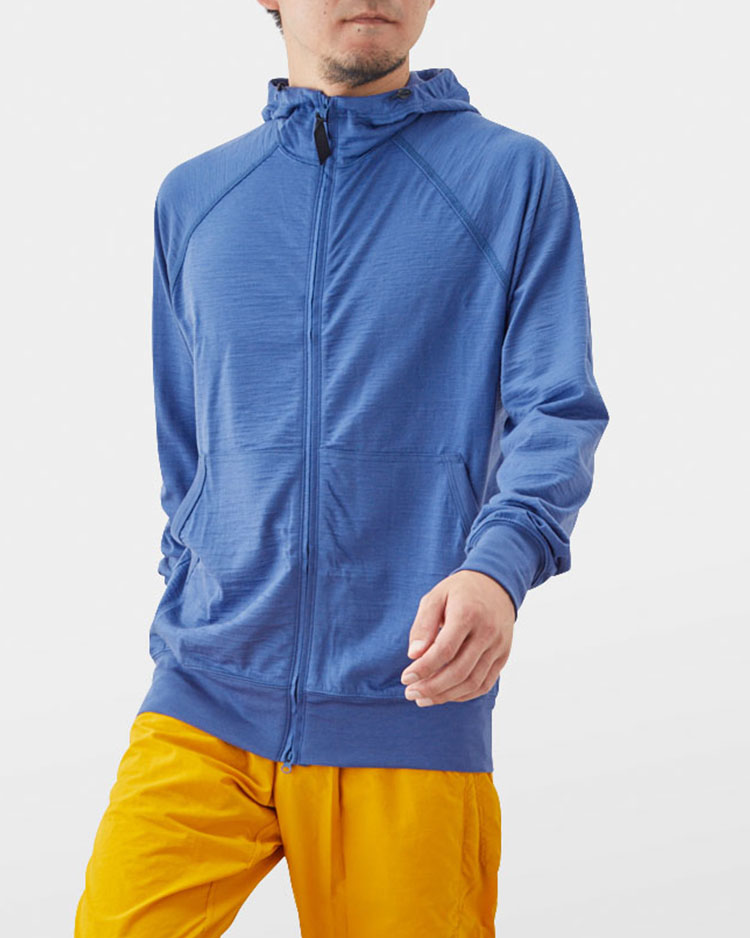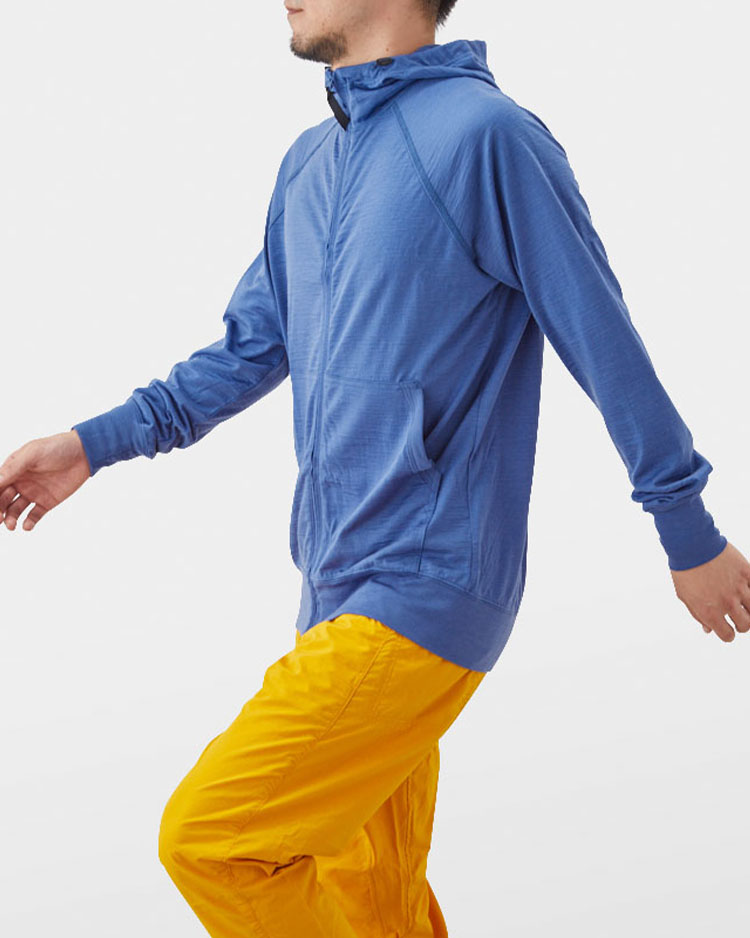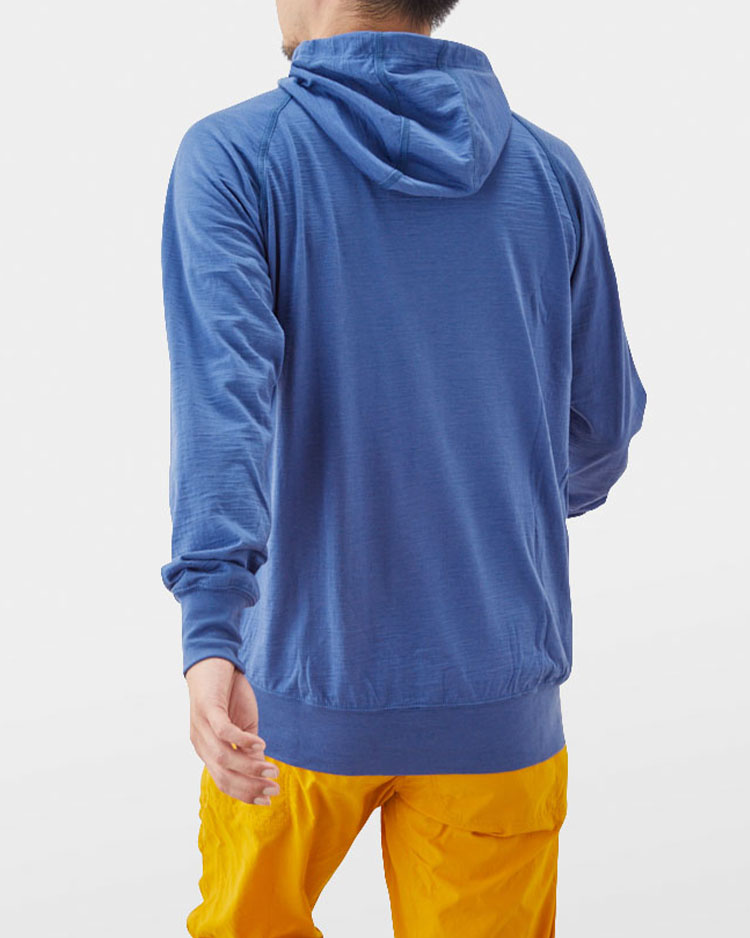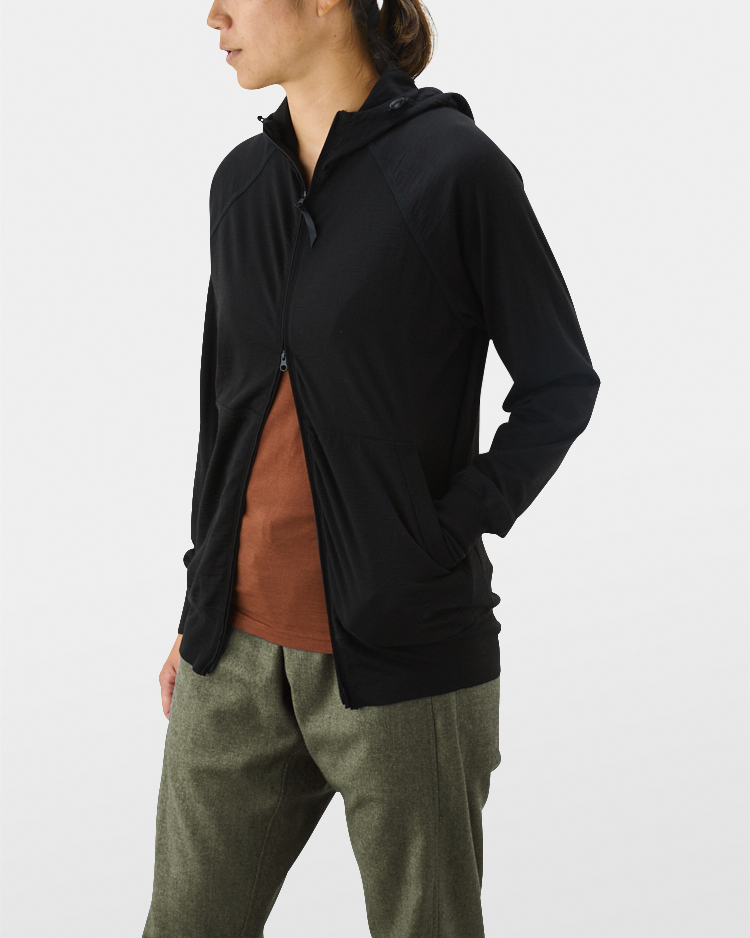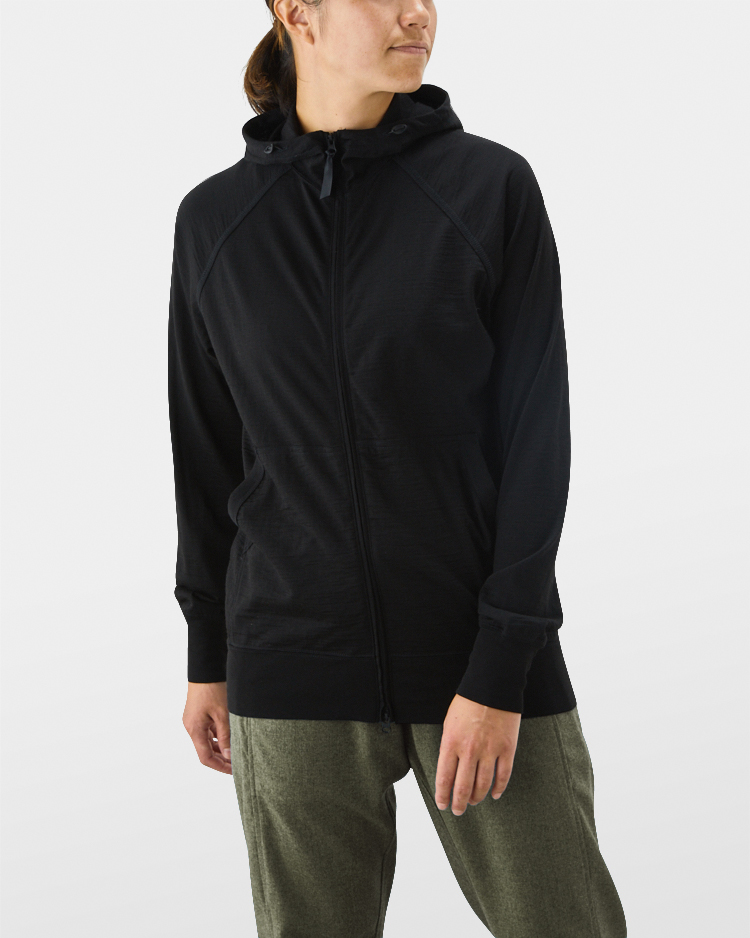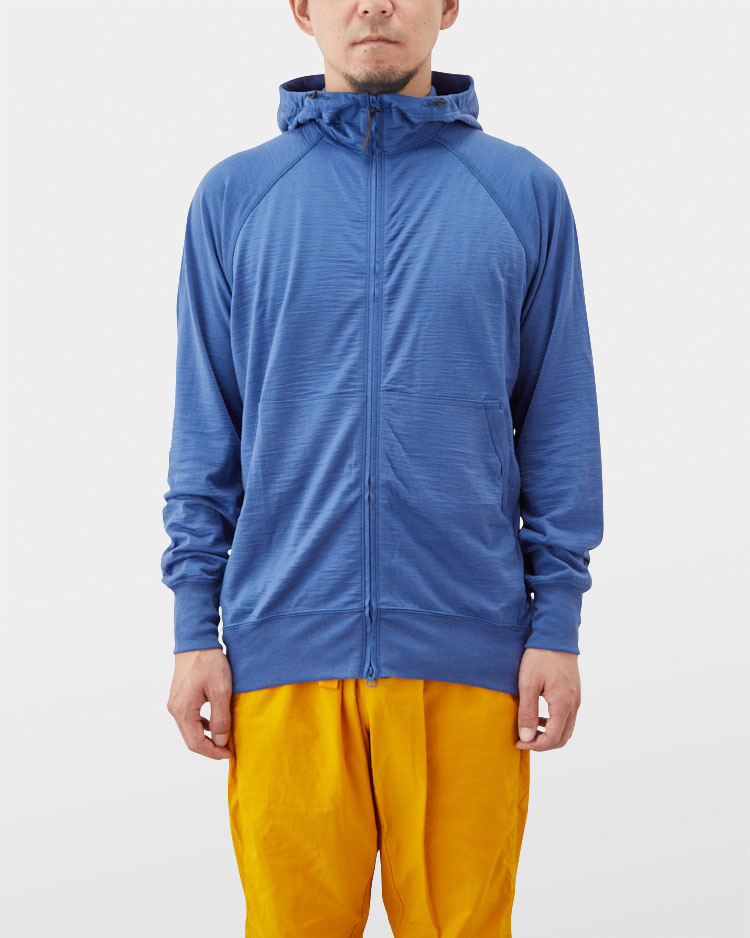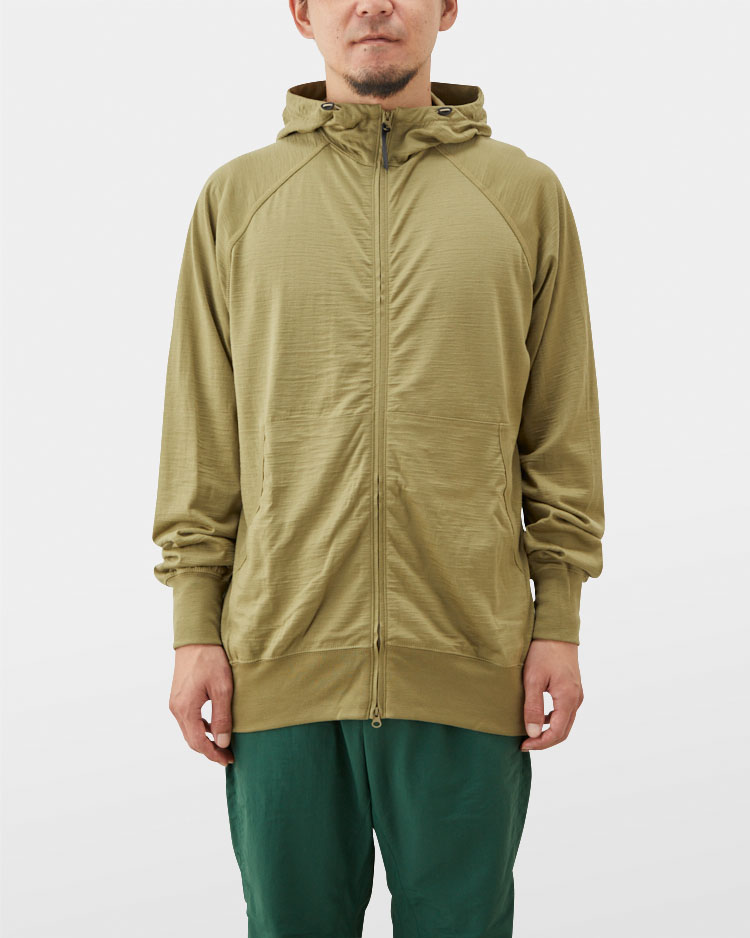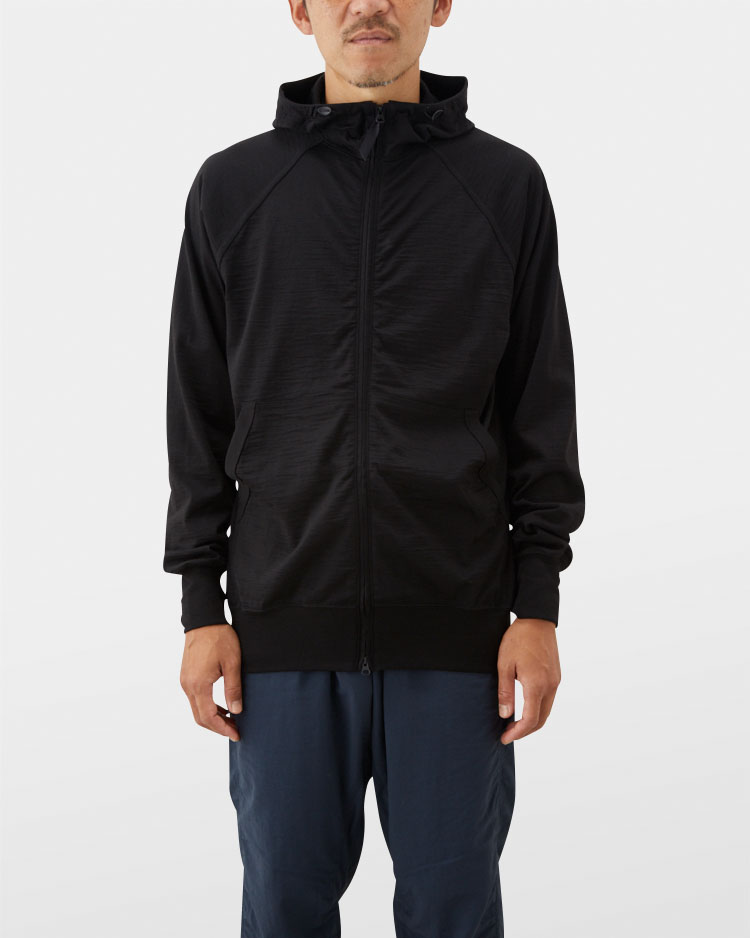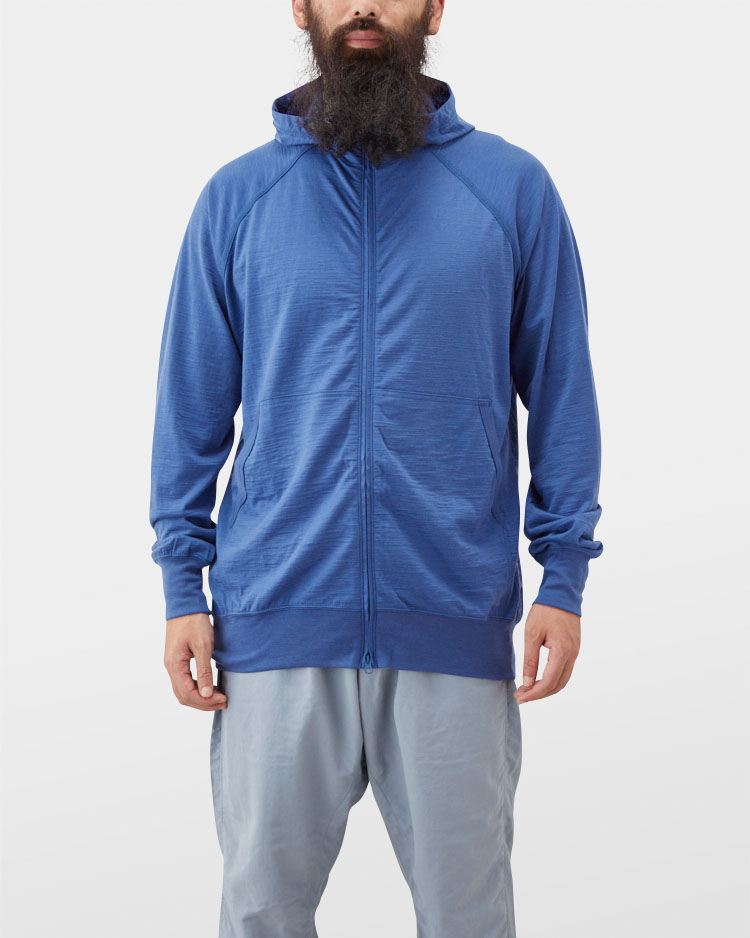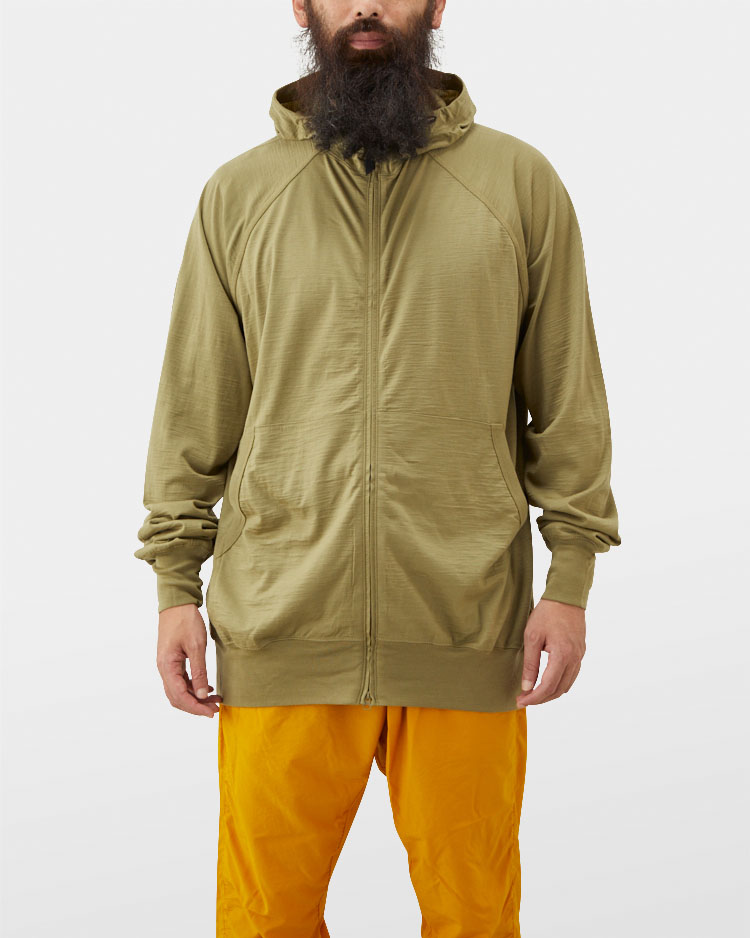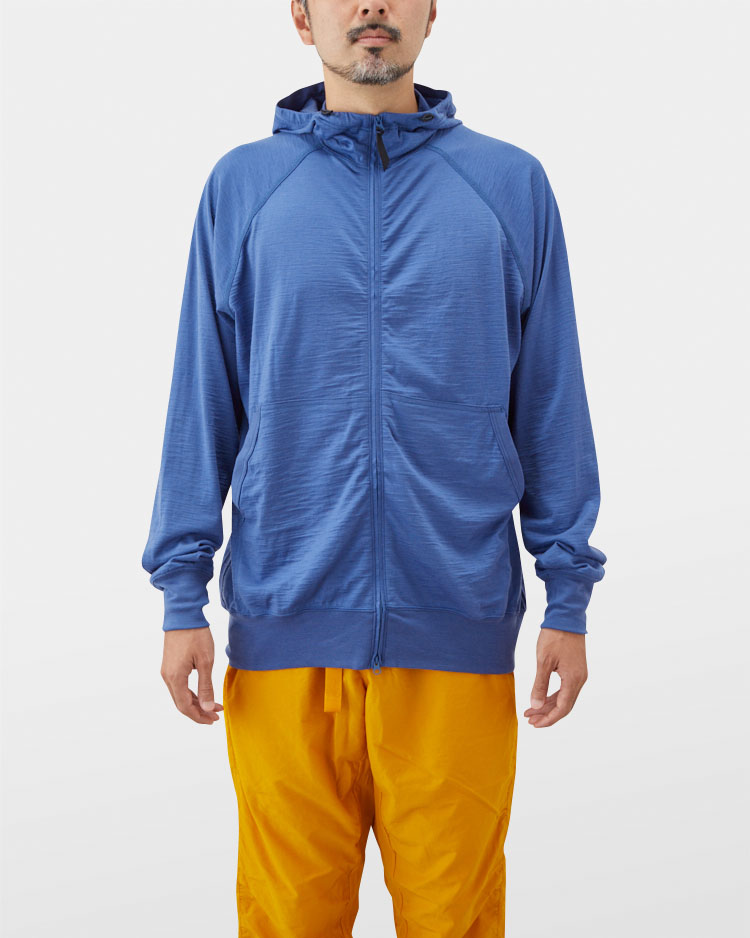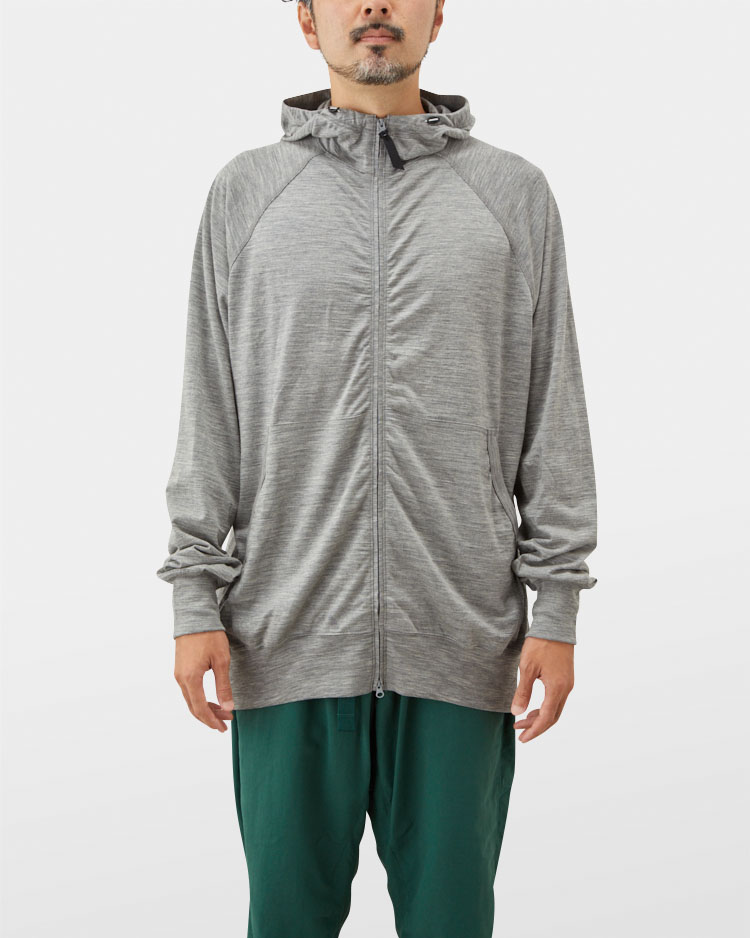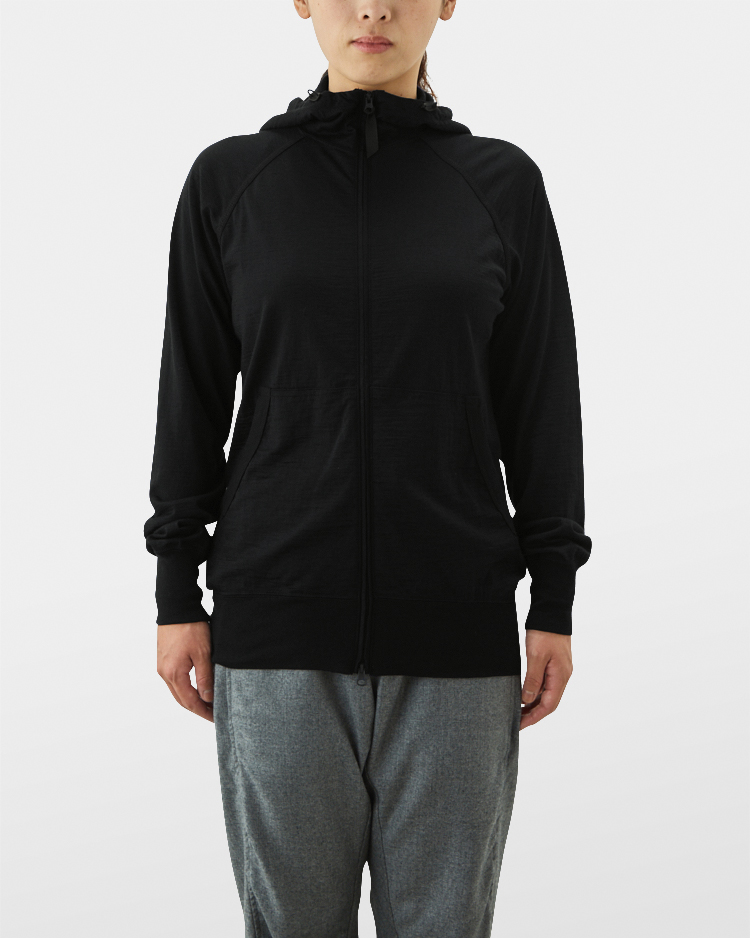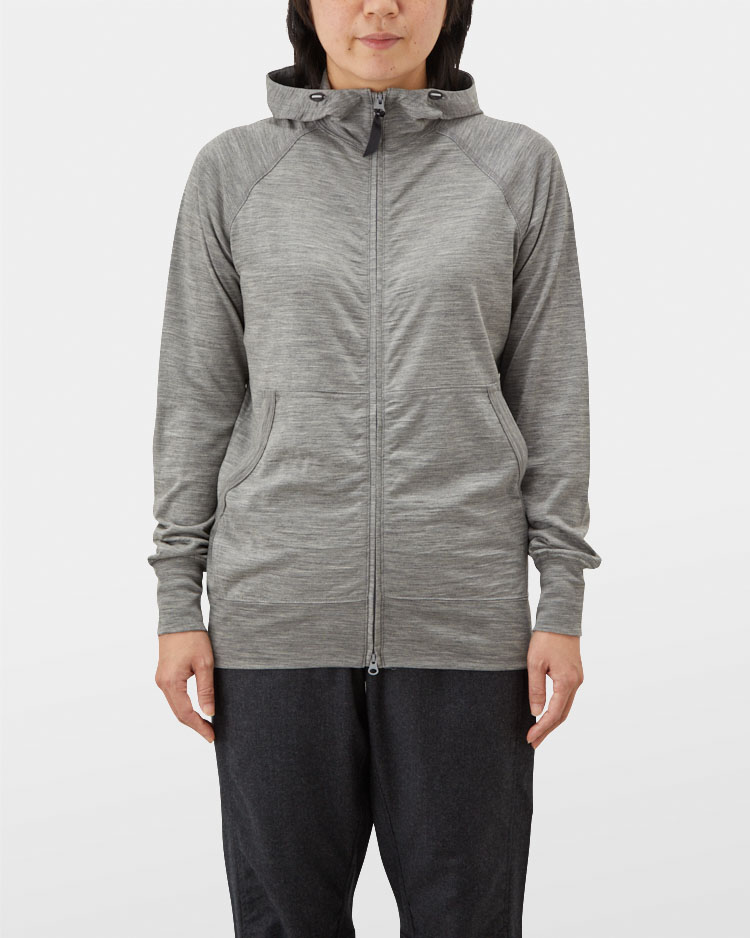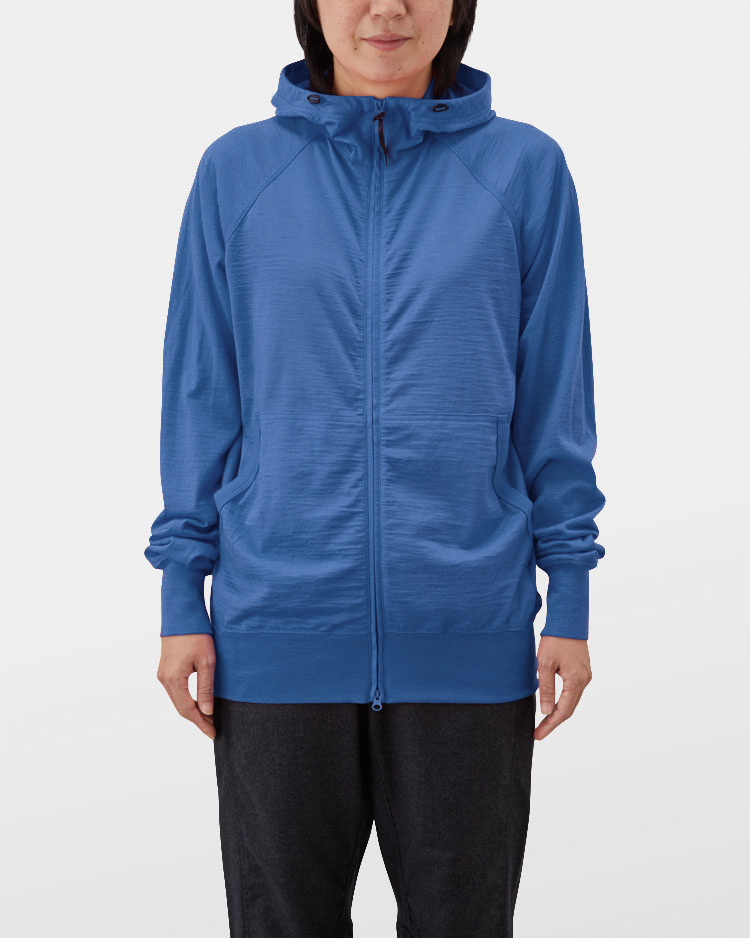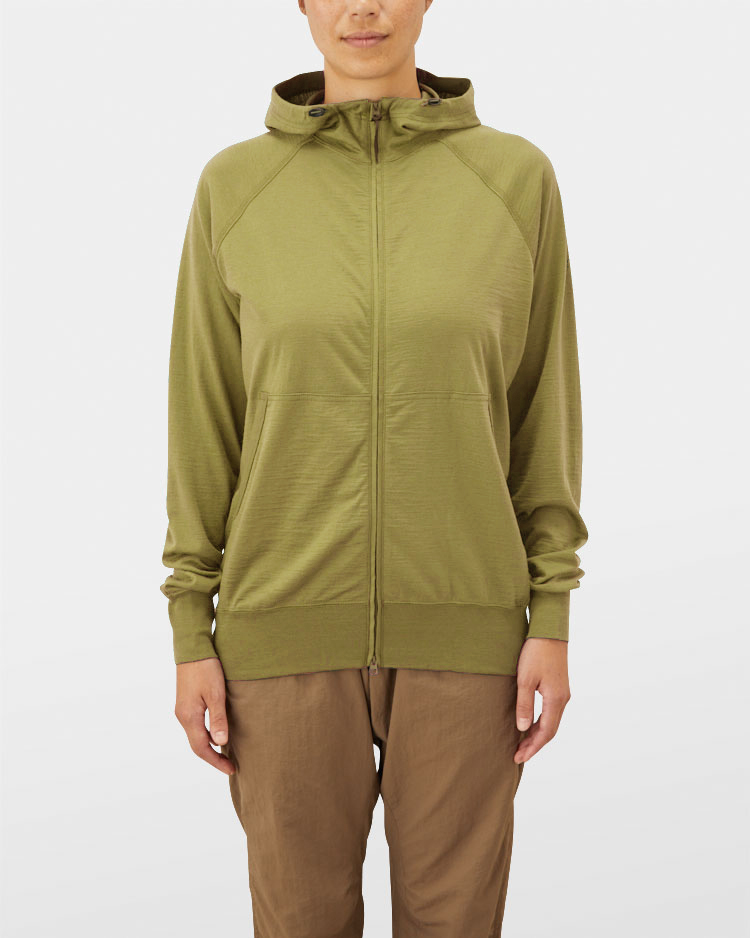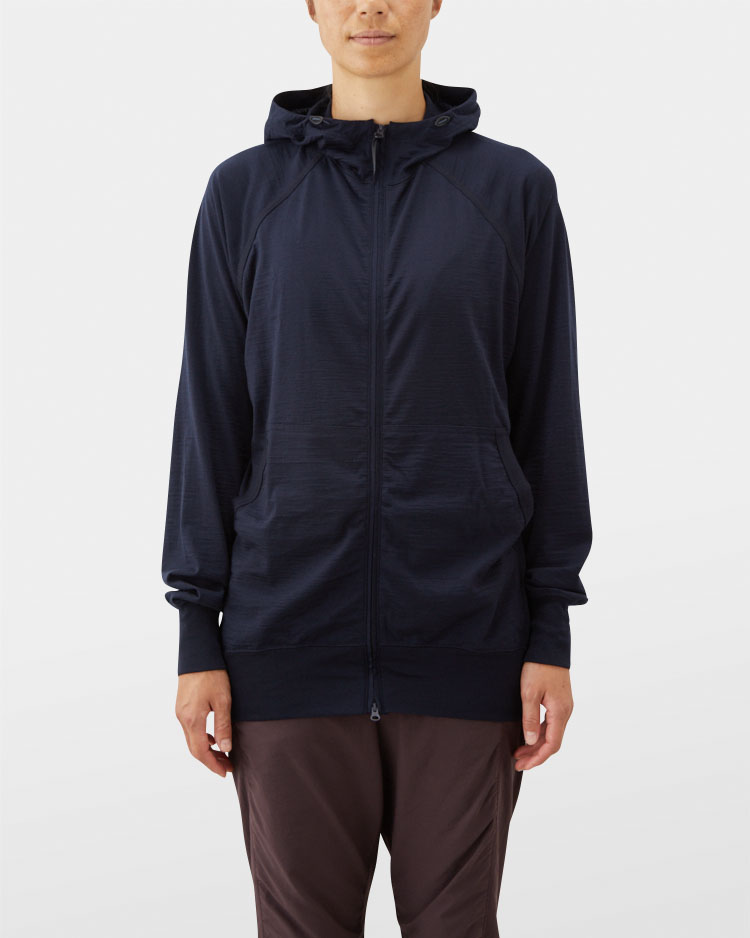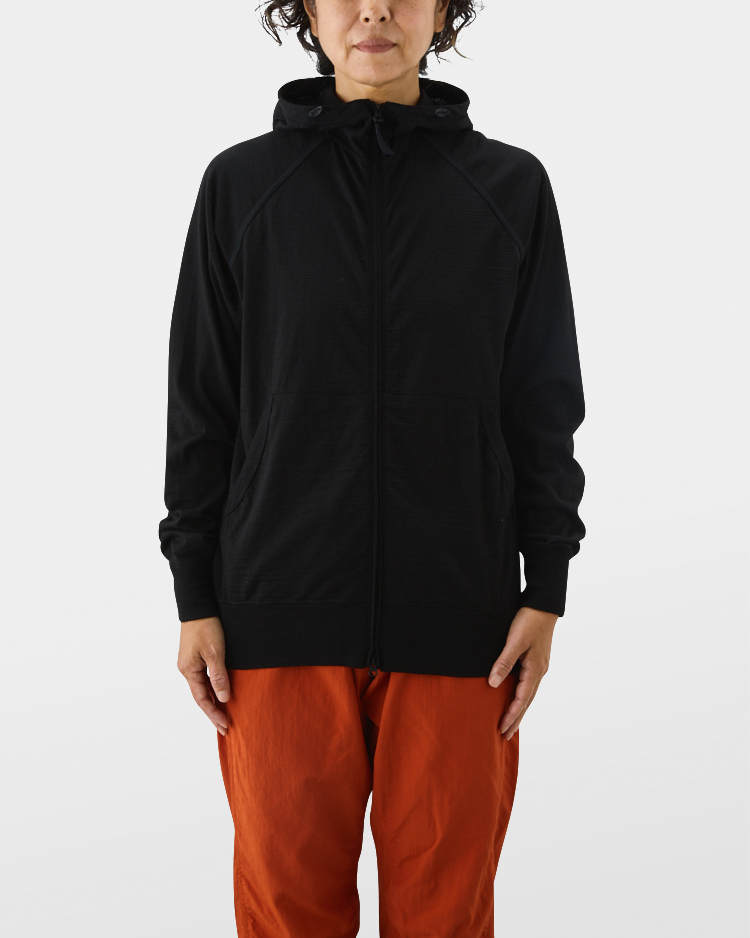335g (Size S)
361g (Size M)
387g (Size L)
418g (Size XL)
- Introduction
- Product Story
- The Full Zip Appeal
- Form and Function
- Where the 100% Merino Stands
- Recommended Scenes
- Naturally Odor Resistant
- Great Moisture Control
- Even Warm When Wet
- Tumble Dryable Pure Merino
- Convenient Ventilation
- Why hoody?
- Ribbed Cuffs and Hem
- Details
- Material
- More Durable and Stable Quality
- Why 100% Merino?
- Disadvantages of Wool
- Size guide
- Instructions
- Hydrophilic 100% Merino
- Tumble-drying
- Care Instructions
Introduction
Double-zip, 100% Merino Hoody
If you think this is just another regular hoody, please read on.
Our proprietary 100% merino wool used for this product is as durable as a merino/synthetic blend and has just the right thickness (200-205g/㎡).
The fabric possesses all the natural temperature, moisture, and odor regulating properties, allowing it to remain comfortable even in situations where it has to be worn for several days in a row. The front double zipper allows for instant ventilation control to prevent overheating during outdoor activities.
Product Story
The Full Zip Appeal
The Yamatomichi Merino Hoody (the old version; the same applies thereinafter, Updated 2021)
was originally designed to retain core heat, so we never really considered adding a full zip.
After giving it some more thought, however, we realized that because a full zip hoody would just have two pockets instead of the large kangaroo pocket, the insulation properties might not change significantly, so we decided to give it a test.

Makoto Fujiyama, wearing the Black color.
After wearing it for a full season, we were impressed with how easily the full zip hoody could be put on and taken off. While the Merino Hoody is suited for continuous outdoor wear during the colder months, the Merino Full Zip Hoody (the old version; the same applies thereinafter, Updated 2021)
can be worn in slightly warmer weather either outdoors or in town. It is perfect for activities that demand breathable clothing or frequent removal.
Form and Function
Where the 100% Merino Stands
Though this product dries slower than general synthetic base layer T-shirts, it is less likely to cause hypothermia caused by the evaporation of sweat or other moisture. In other words, the new 100% Merino series focuses on moisture absorption rather than quick-drying, and on thermal insulation rather than cooling properties.

Recommended Scenes

When the temperature changes drastically
Wool is good at maintaining a constant temperature inside the garment, keeping you dry and comfortable even in situations where temperatures can suddenly change.
When worn under an outer shell
Synthetic base layers with low moisture absorption can feel very humid and stuffy. On the other hand, our 100% Merino’s superior moisture absorption properties, will help to keep you dry and comfortable when worn under an outer shell.
When worn for long hours
Synthetic clothes often become smelly relatively early on, even if they are deodorant finished. Wools, on the other hand, naturally eliminate odor when the fabric dries even after being soaked in sweat. This powerful anti-odor performance allows you to keep moving day after day, relatively comfortably without smelling too bad. Also, our proprietary 100% Merino can be tumble dried at a low temperature, making it easy to wash and dry on the go.
When packing capacity is limited
Our Merino wool products can be worn in various situations for long hours without getting too smelly, minimizing the need for extra clothes in your backpack.
Naturally Odor Resistant
Wool base layers are chosen by many hikers for the material’s excellent odor neutralizing performance. Some say it’s almost odor-free even after a week of heavy hiking, but we’ll let you (and your friends) be the judge of that…

Wool’s deodorant mechanism is still a mystery. One theory has it that wool absorbs a large amount of odor-causing elements, and consequently, the odor is minimized to the level that cannot be detected by the sense of smell. We will conduct our own experiments and tests in the future.
Great Moisture Control
Wool is great to help you keep warm and cool as it naturally controls the moisture level within the clothes, always keeping you comfortable throughout the year.
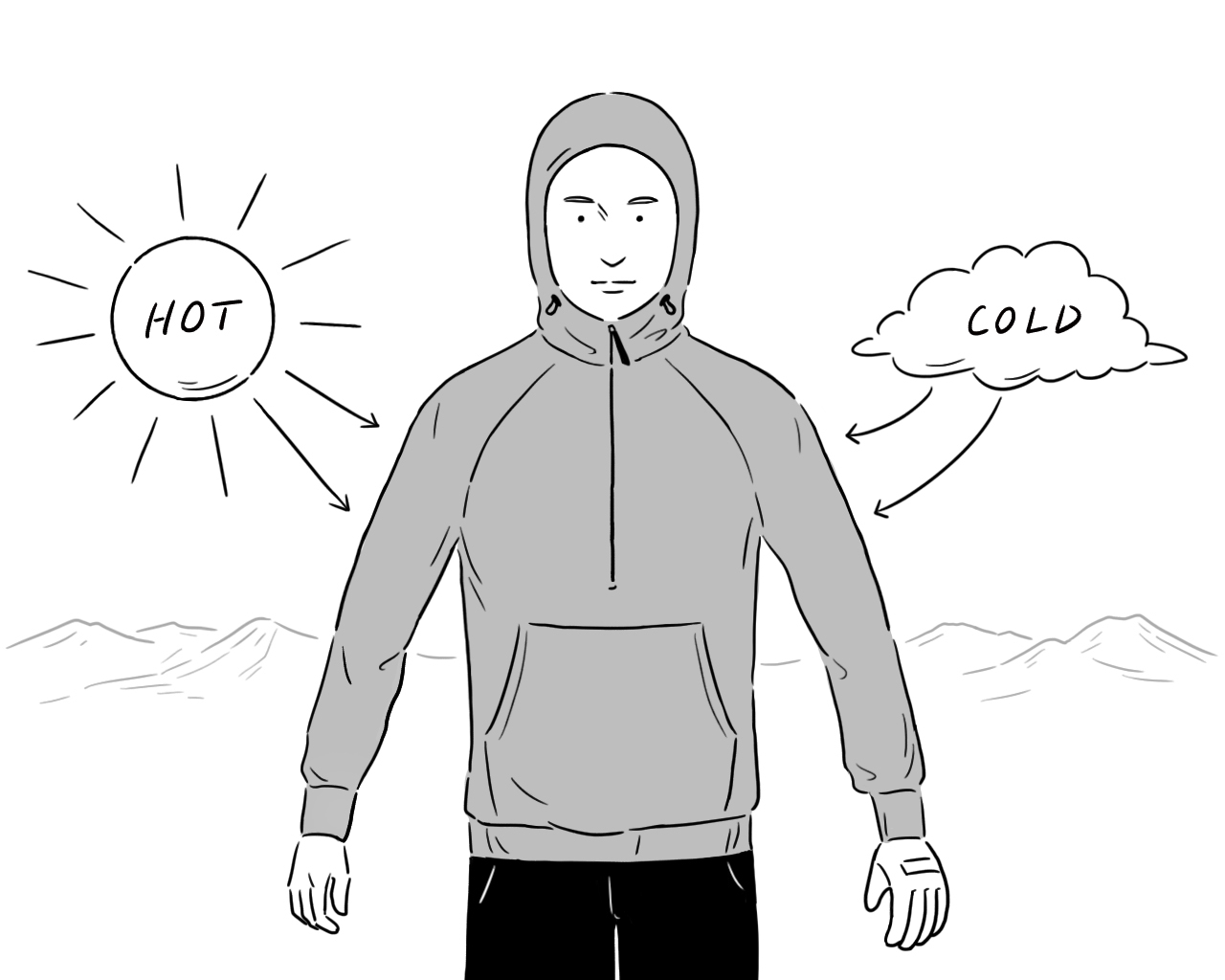
Wool’s peculiar function is the benefit of the dead-air space between the crimped wool fibers, allowing for the excellent breathability and moisture permeability. Furthermore, the cortex’s water absorption performance variably changes according to the humidity level of the outer air, that is, the higher the humidity outside, the more moisture it absorbs.
The air layer inside the fiber made by the “crimp” works as a loft to retain heat in the same way as down and synthetic fibers, and it performs better thermal insulation than cotton and synthetic fibers of the same weight.
Even Warm When Wet
First, when wool absorbs moisture, the thermal phenomenon called “absorption heat” is generated. Secondly, its excellent insulation properties (low thermal conductivity) prevents the body heat from being lowered by evaporation. Also, the crimped fibers are bouncy and retain loft without crushing even when wet. In addition, wool can absorb more moisture in between the fibers, always keeping the skin dry and comfortable.
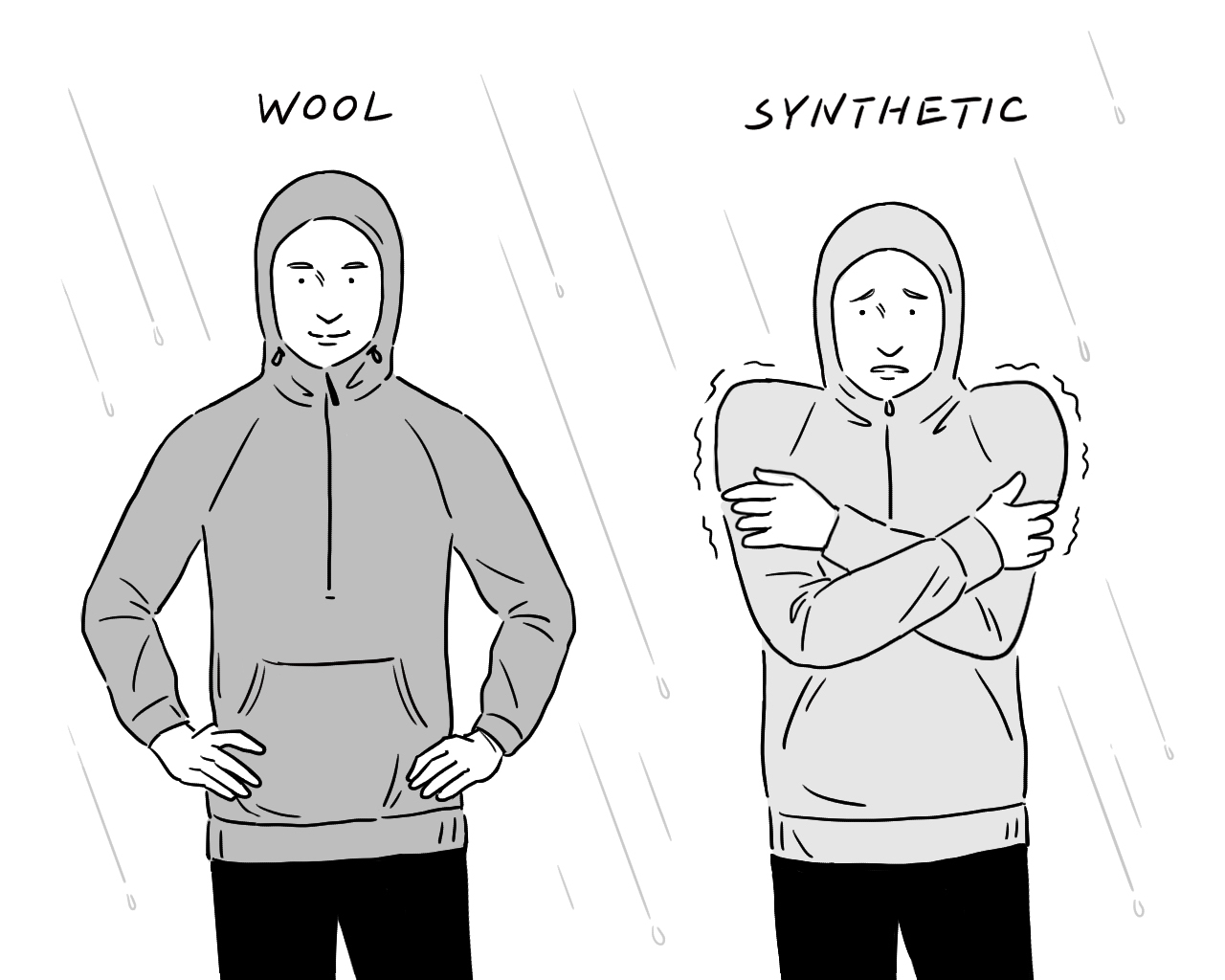
When fibers absorb moisture, the thermal phenomenon called “absorption heat” is generated. The wool’s adsorption heat performance is twenty times of polyester, and 2.5 times of cotton.
Tumble Dryable Pure Merino
Normally, Merino wool products cannot be tumble dried as the heat causes shrinkage and deformation of the fabric, but our proprietary 100% Merino wool can be tumble dried* at low temperatures (Upper limit of 60 Celsius).
This makes it better suited for long hikes and travels, as you can easily use dryers at laundromats and hotels.
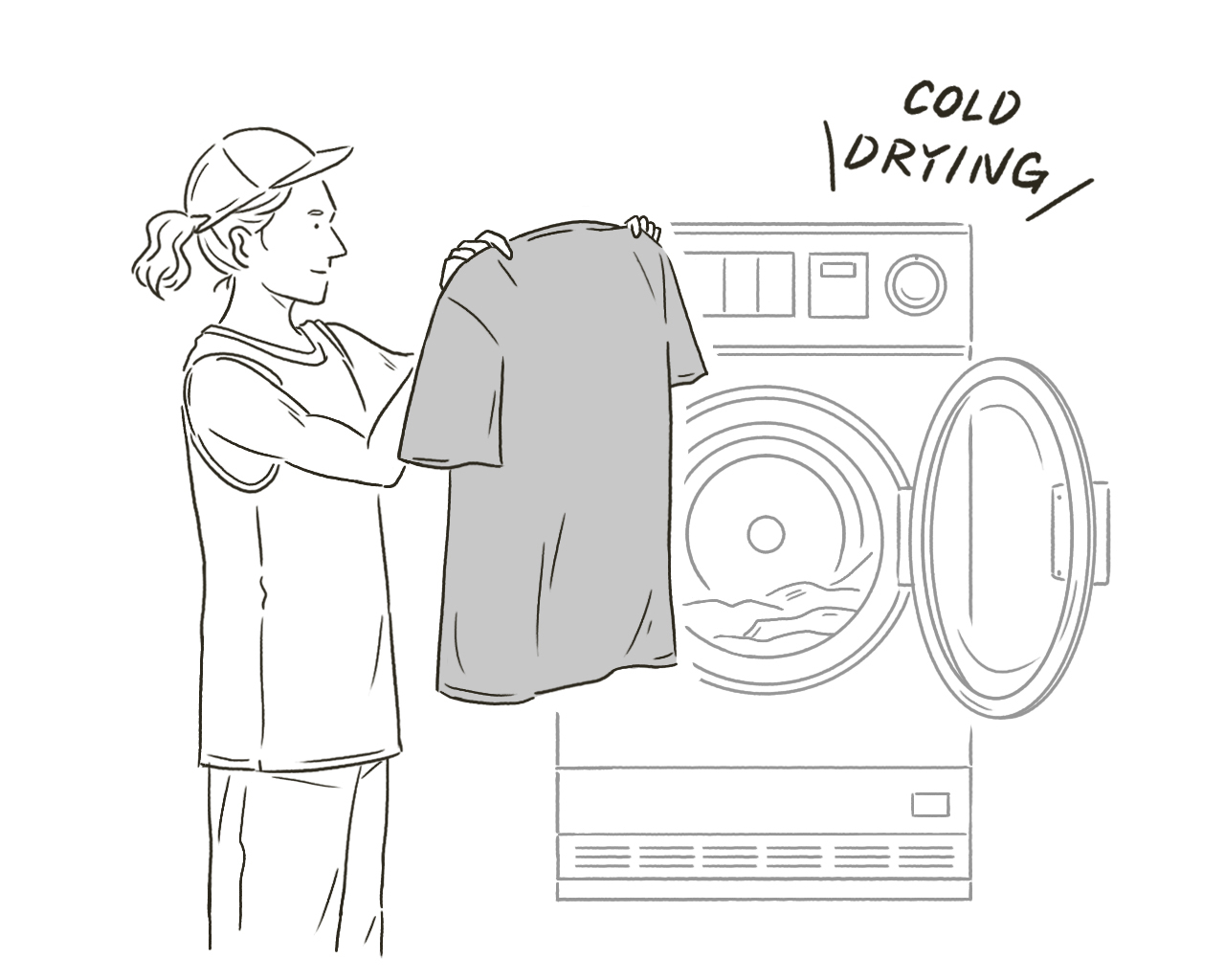
*Some shrinkage may be caused by tumble drying, but the shirt will return to its original shape as you wear it. Repeated use of the dryer may deteriorate the fabric, so we recommend using it only when necessary.
Convenient Ventilation
The front two-way zipper accelerates ventilation performance.
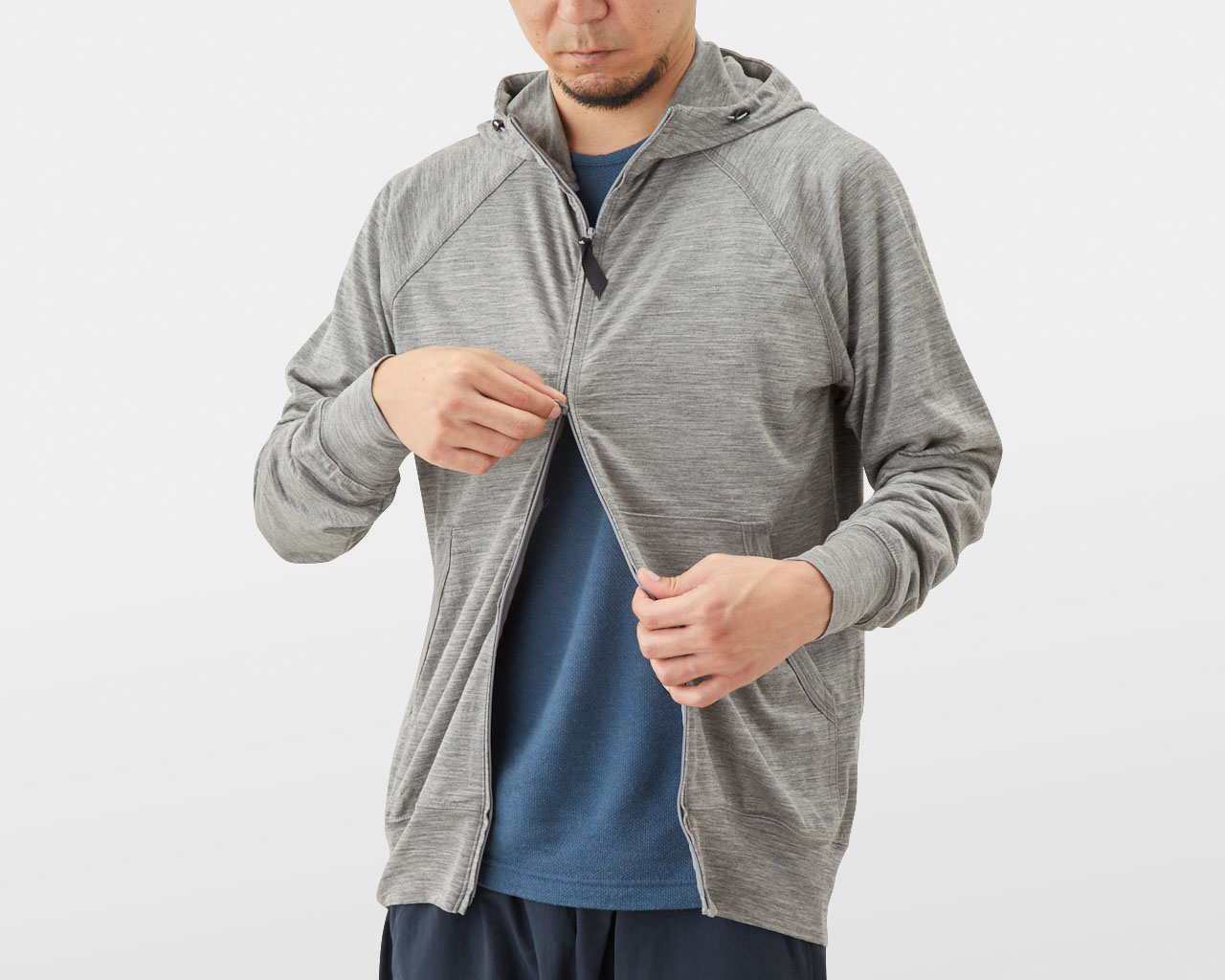
Why hoody?
When feeling a little cold, just put on the warm hood for quick and comfortable added warmth. In extremely cold and snowy mountains, balaclavas that cover your nose will keep you warmer, but except for these rare occasions, generally, we think balaclavas are a bit too much. Our hoody’s zipper ends at the chin and is adjustable with the 2mm stretch cord and a simple stopper, allowing for easy adjustment on the go.
The hood shape has been revised since the 2022 version, and now uses the three-ply pattern to make it more compact and better-fitting on your head.
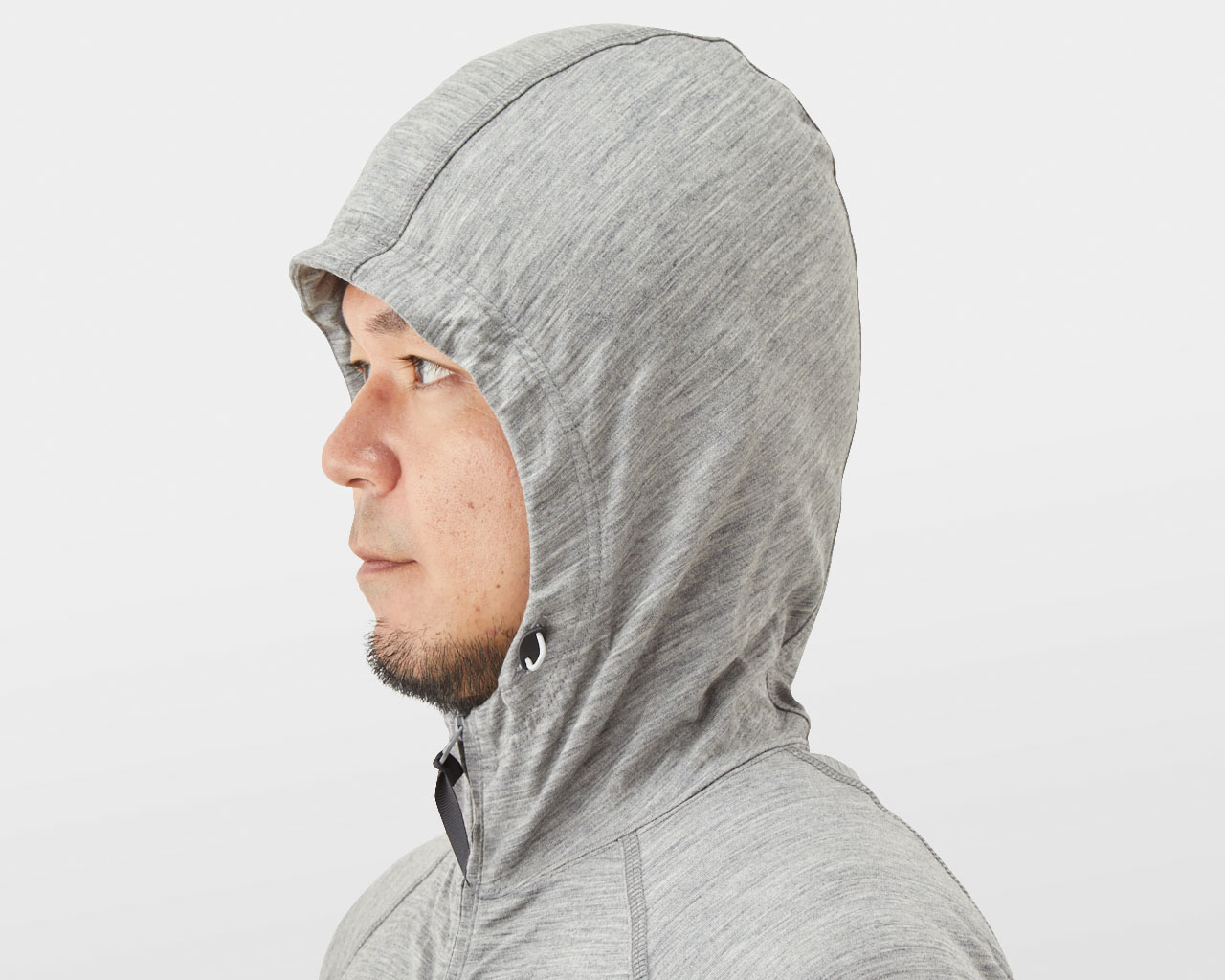
Ribbed Cuffs and Hem
The ribbed cuffs work as simple wrist warmers, helping to prevent heat loss and keep out the cold. By rolling up your sleeves you can quickly and effectively cool down. The thick ribbing helps retain warmth, which is important, as the abdomen, lower back, and buttocks are susceptible to the cold.
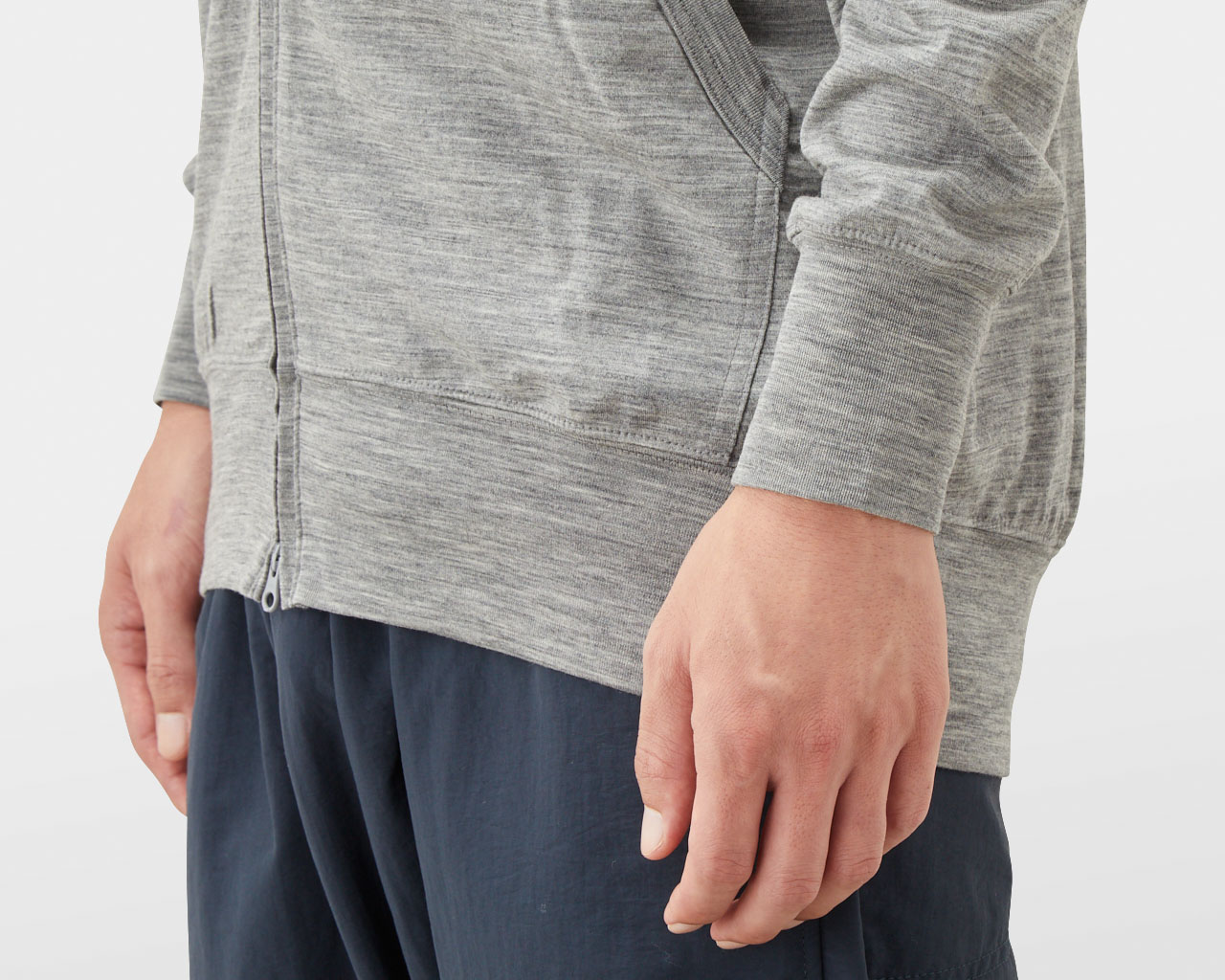
Details
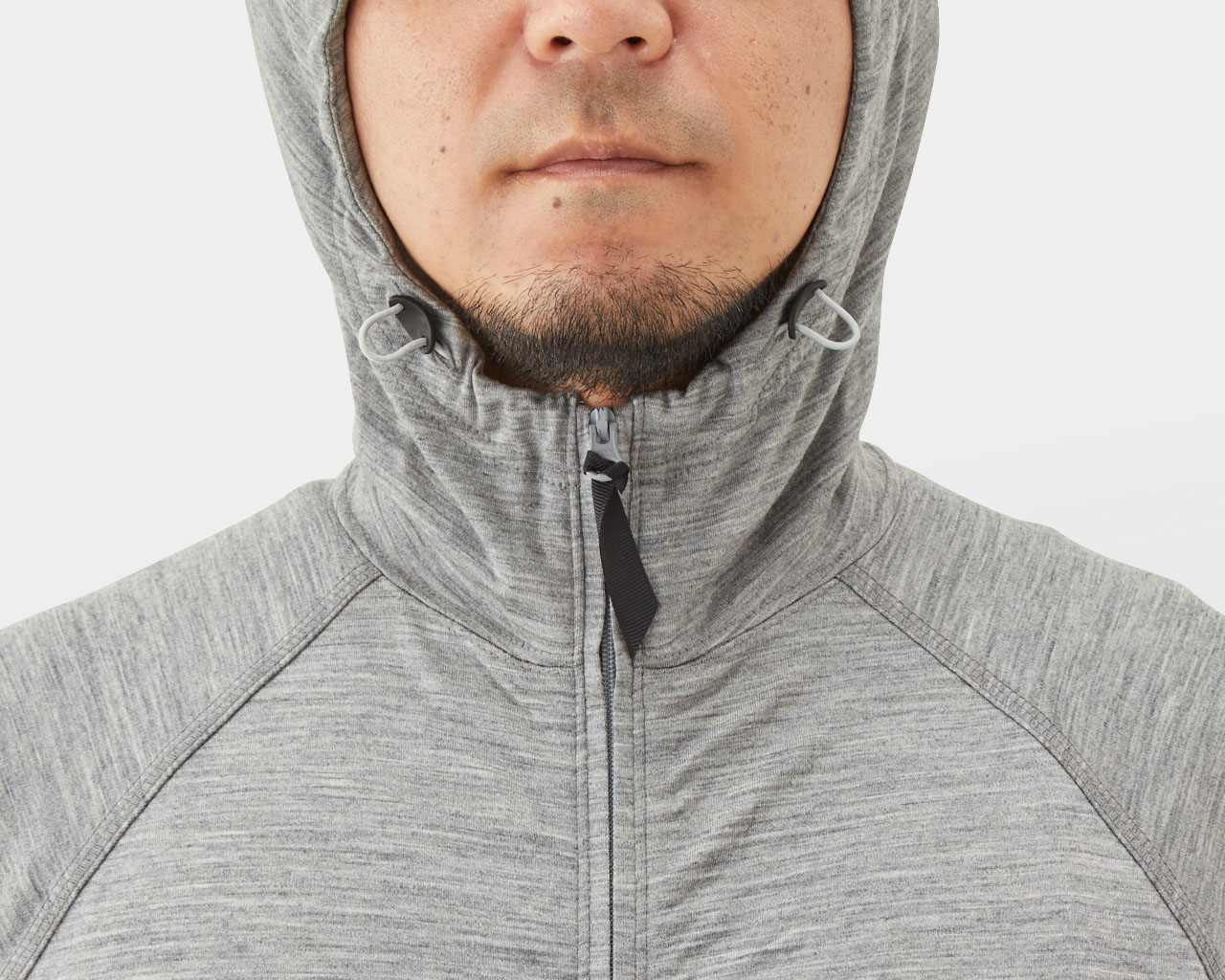
The hood is adjustable with the 2mm stretch cords and stoppers.
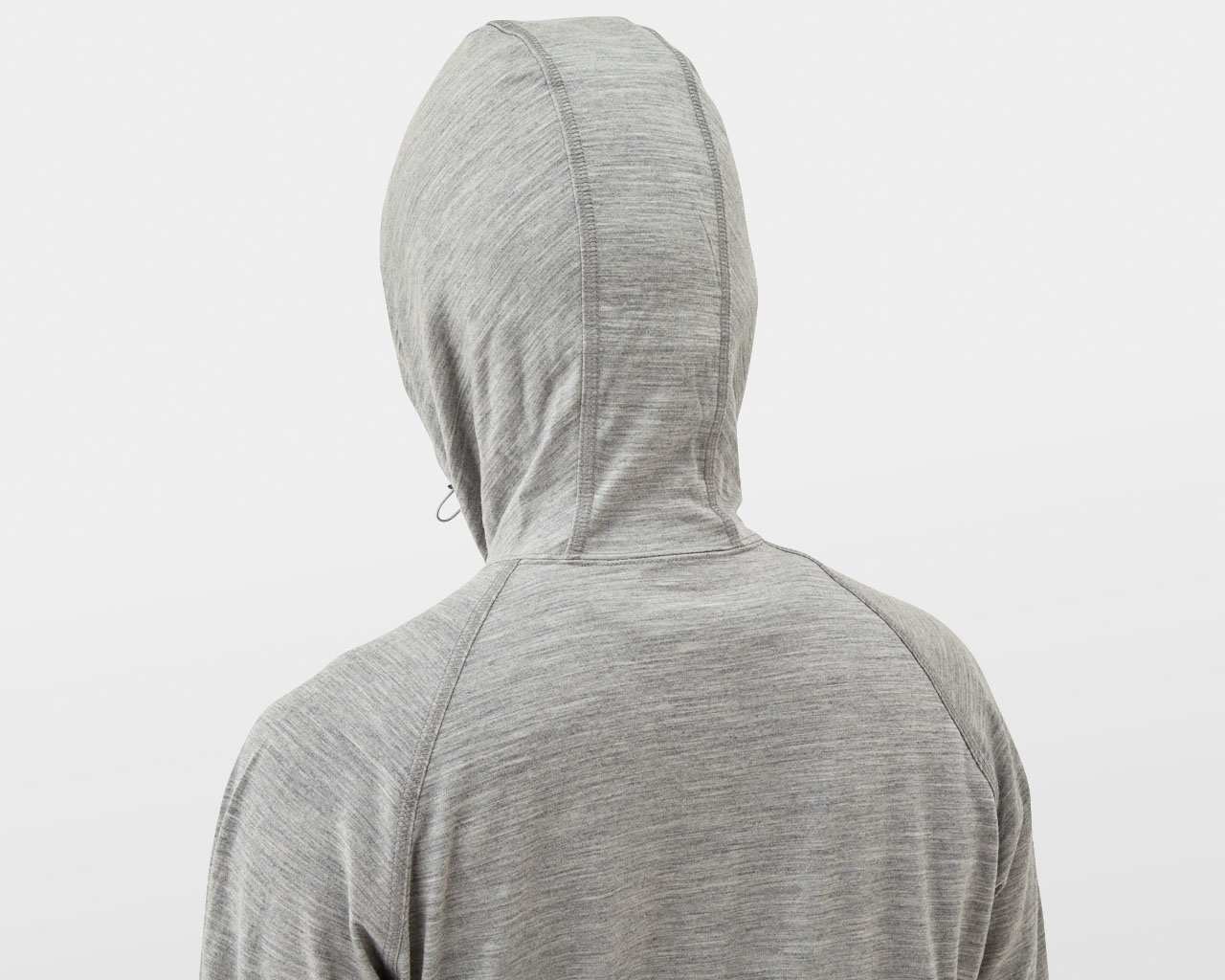
The raglan sleeves enable easy movement of the shoulders and arms.
Material
More Durable and Stable Quality
Our previous Merino series was produced by a combination of two strands of wool twisted together, known as “ply yarn”, featuring light and soft texture. However, this method could cause shrinkage after washing, possibly resulting in the partial bursting of the fabric.
So we analyzed the New Zealand Merino wool that we used in our old products to examine the optimal spinning and knitting methods; Our conclusion was to work with single yarn.
The fabric is pre-shrunk through tumble drying, which is a rare process for Merino clothes, making the fabric tight and compressed but bouncy. The process makes the fabric softer and more stable, allowing it to be tumble-dried at a low temperature.
Our proprietary fabric is produced in Bishu, the production area of wool garments in Japan, in cooperation with the spinning company, fabric factory, dyeing, and processing factory, and inspection organization. We continue our effort to innovate with new products and markets.
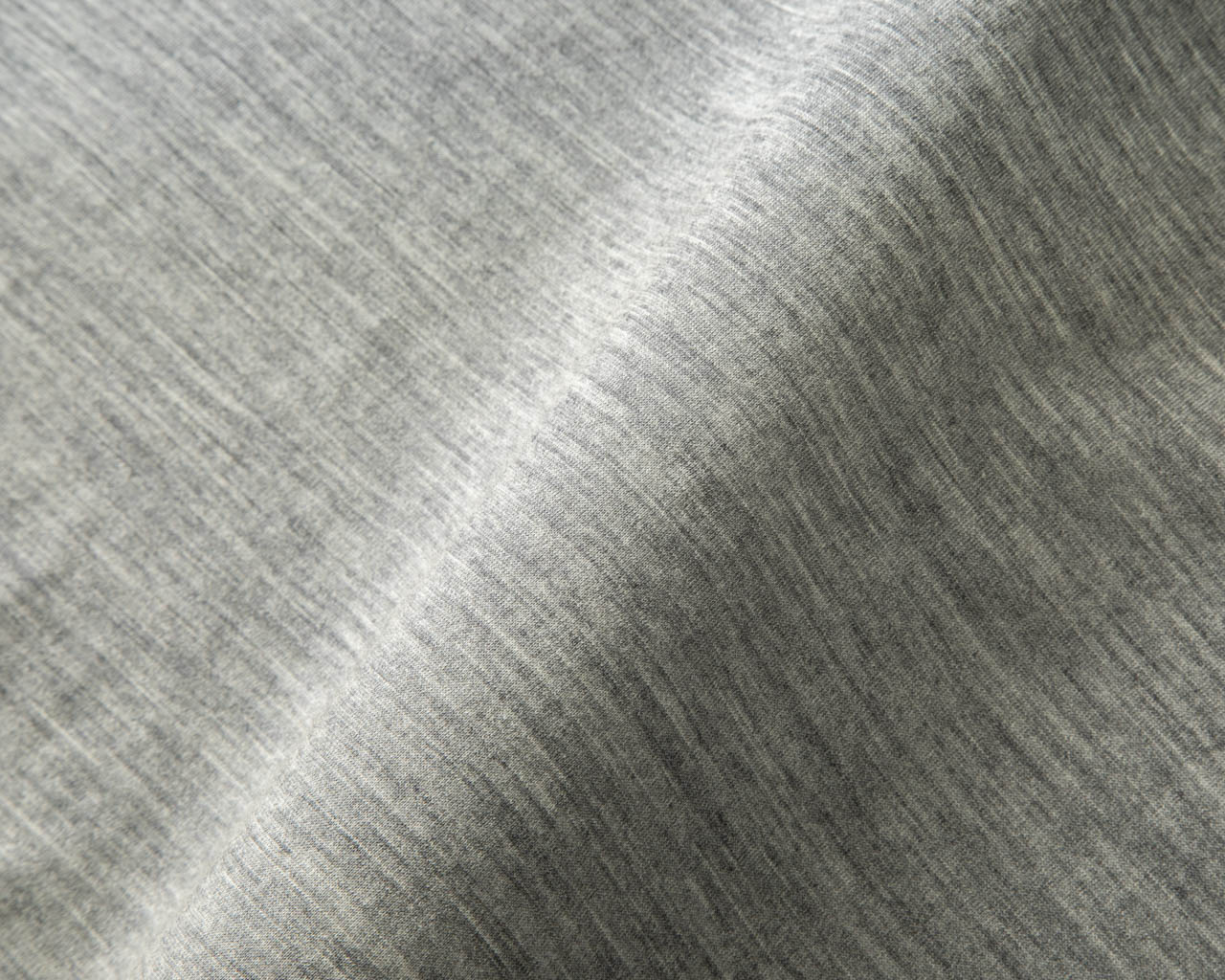
100% Merino Wool
Weight: 200-205g/m²
Yard count: 1/38
Bursting strength (JIS L1096A): 400kPa
*The value of the pressure when the rubber membrane tears the fabric as the membrane is continuously pressurized.
Heat retention (JIS L1096A): 24%
*Energy loss when the fabric is placed on the heat source.
Why 100% Merino?
Wool is a natural material with various unique features such as temperature/moisture control, thermal insulation, and is naturally odor-resistant. All developed by sheep to survive the harsh environment over time.
Merino wool comes from merino sheep and compared to other kinds of wool, merino’s fiber is finer, softer, and less scratchy, and hence even suitable for making underwear and baselayers.
All wool, including merino wool, is cool in summer and warm in winter. It is warm even when it’s wet, and practically odor-free even after many hours of wear.
While many other manufacturers add synthetic fibers to strengthen their Merino fabrics, we wanted to stick with 100% Merino to maximize the natural benefits of pure merino wool. Our merino will keep you dry even when it’s hot and humid and comfortable no matter the climate.
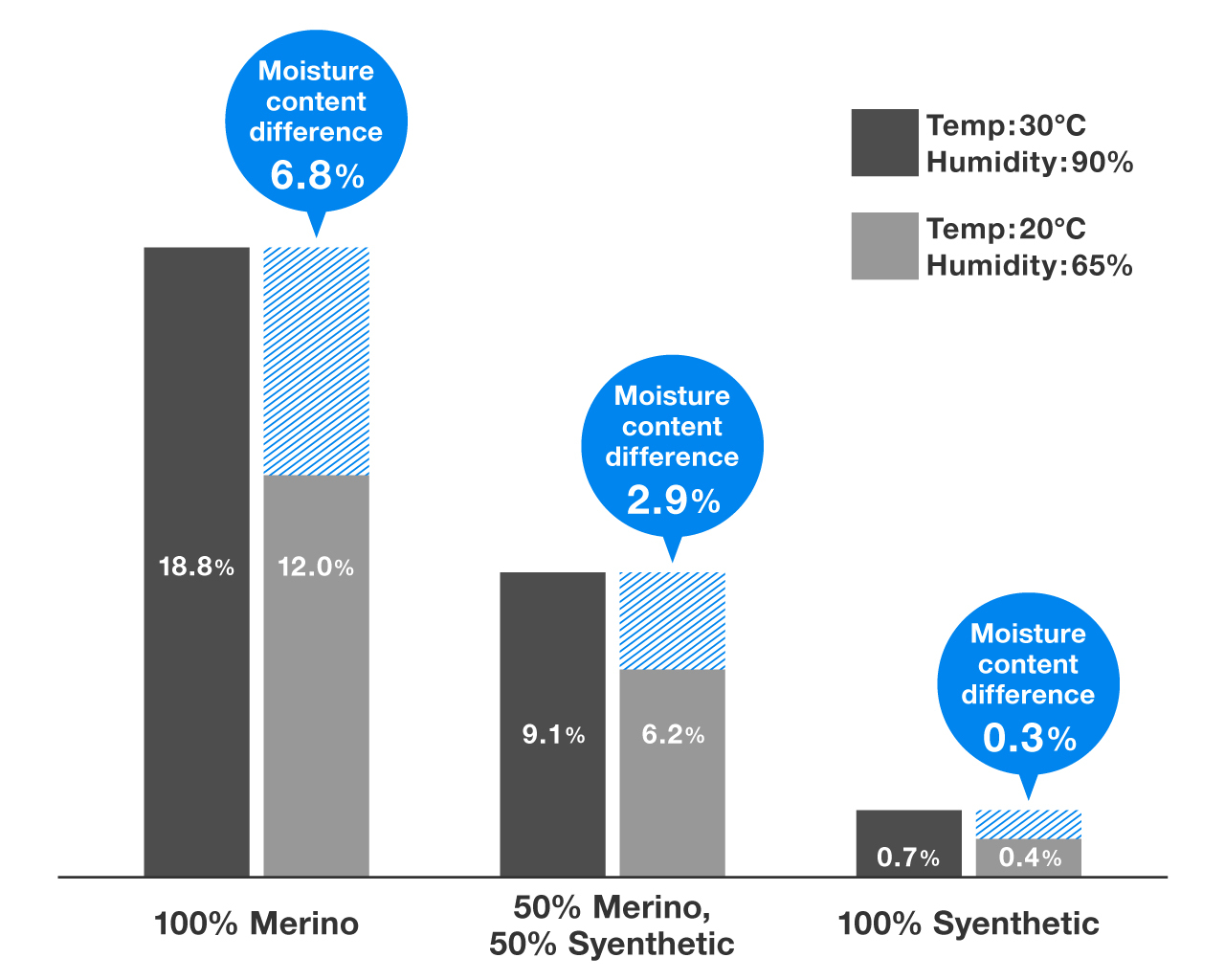
The above chart shows the comparison of moisture content ratio of three types of fabrics in a humid and hot environment (up, 30˚C with 90% humidity) and a more comfortable environment (down, 20˚C with 65% humidity).
In a humid and hot environment, the fiber with superior moisture absorption keeps you dry and comfortable. On the other hand, in dry conditions, it is more comfortable when the fiber provides a certain level of moisture without excessively absorbing available humidity. The difference of the moisture content ratio in the above chart indicates the moisture control performance: the greater the value is, the better the fabric’s moisture control performance is, therefore the larger percentage means better comfort.
The 100% merino fabric, as shown above, has a 6.8% moisture ratio difference. This means that our merino material can effectively control the moisture compared to the other fabrics, keeping you dry when it’s hot and humid while supplying a moderate amount of moisture when the humidity is low. This is the reason why the merino wool is known as “a natural air conditioner”.
Merino Wool
Wool is a natural material with various unique features such as temperature/moisture control, thermal insulation, and anti-odor performance; all of them developed by sheep to survive the harsh environment over time.
Merino wool comes from merino sheep and compared to other kinds of wool, merino’s fiber is finer, softer, and less scratchy, and hence even suitable for making underwear.
All wools, including merino wool, are cool in summer and warm in winter. It is warm even when it’s wet, and practically odor-free even after many hours of wear.
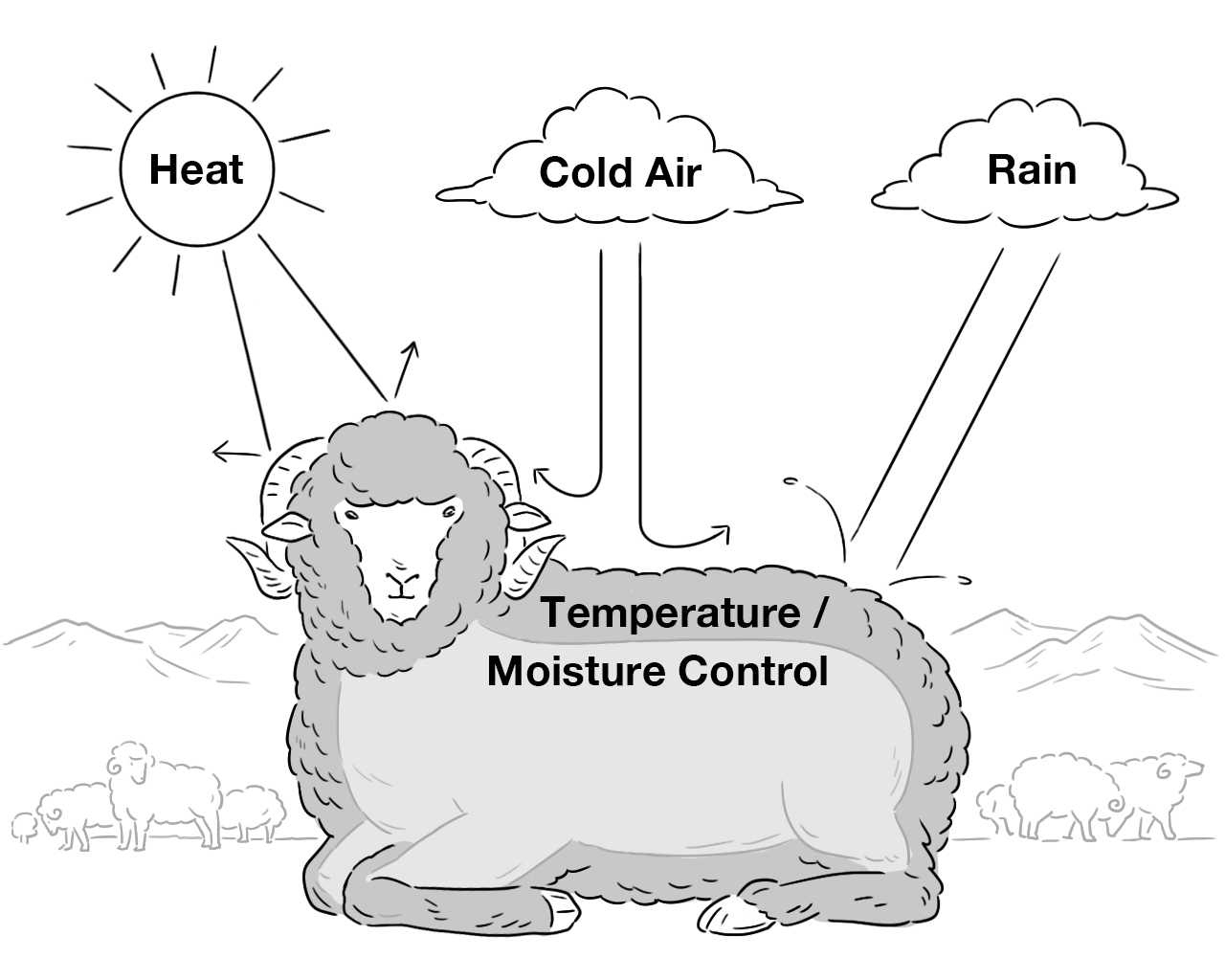
Wool’s Structure
The wool’s fiber is composed of amino acid-based protein, just like human hair and skin. The surface is called the “scale”, which is similar to a fish scale, and the inner part is the “cortex”.
The cortex is composed of ortho-cortex and para-cortex, each with different moisture absorption performance. Because each of them differs in property, the combination of ortho and para cortexes makes the fiber “crimped”.
This crimped structure produces the wool’s unique features such as moisture/temperature control property and thermal insulation performance, avoiding the coldness caused by the sweat.
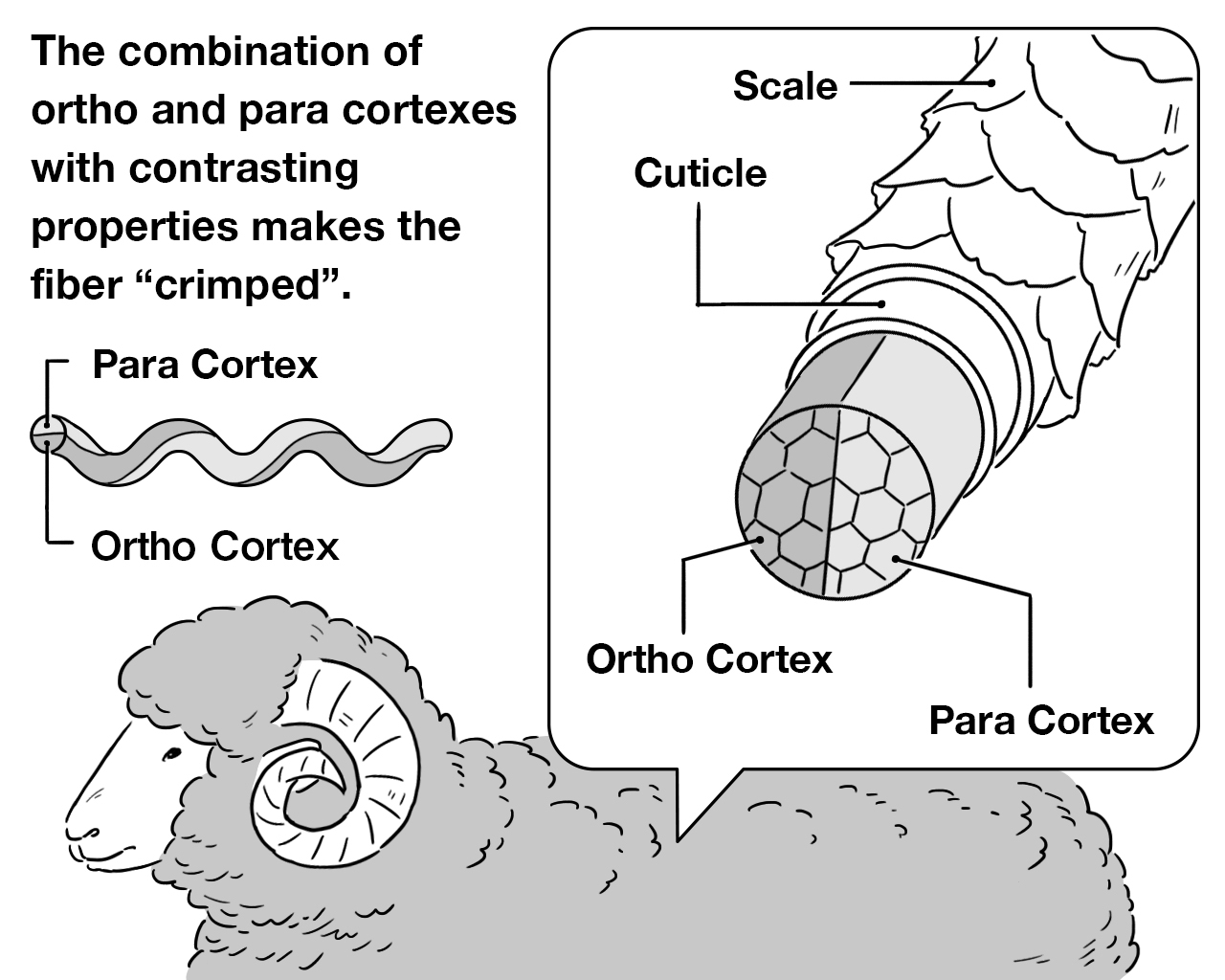
Disadvantages of Wool
Wool or merino wool has various features and functions, but it is not flawless.
- Heavy when wet
when it’s wet and takes longer to dry compared with most synthetic materials. Fast-drying synthetic materials, however, can be cold when wet because it deprives body heat excessively quickly as it dries due to evaporation. Wool dries slower than synthetic materials but quicker than cotton with a similar thickness.
- Liked by insects
Soft, natural fibers such as wool, cashmere, and silk are prone to damage by insects.
- Tears easily
The relatively short fibers of wool mean that wool fabrics are easier damaged than synthetic and cotton fibers. However, small holes can easily be fixed with a bit of pure wool and a needle.
- Shrinks easily
Wool generally shrinks easily, even when shrink-proofed. To reduce shrinkage, after the wash, please spread the shirt well to return to the original shape and gently iron it.
- Distortion
When knitted wool fabrics are washed, the material is likely to distort diagonally because the yarned fibers absorb water, swell, and tend to untwist. Consequently, the shape of the shirt may distort slightly with washing.
- Distinctive smell
The wool comes from sheep and you may experience a distinctive animal-like smell coming from your t-shirt when damp. This smell disappears after the fabric dries.
The above information was compiled and edited based on the interview with the textile company and the research institute, and the reference book below:
Bibliography: Structure and Physical Properties of Wool, Japan Wool Industry Association, Seni Co., Ltd.
Size guide
Recommended Size
| Size | XS | S | M | L | XL |
|---|---|---|---|---|---|
| Weight (kg) | 42~53 | 51~61 | 59~69 | 67~78 | 76~85 |
| Chest (cm) | 78~84 | 80~88 | 84~95 | 92~102 | 100~110 |
Product Size
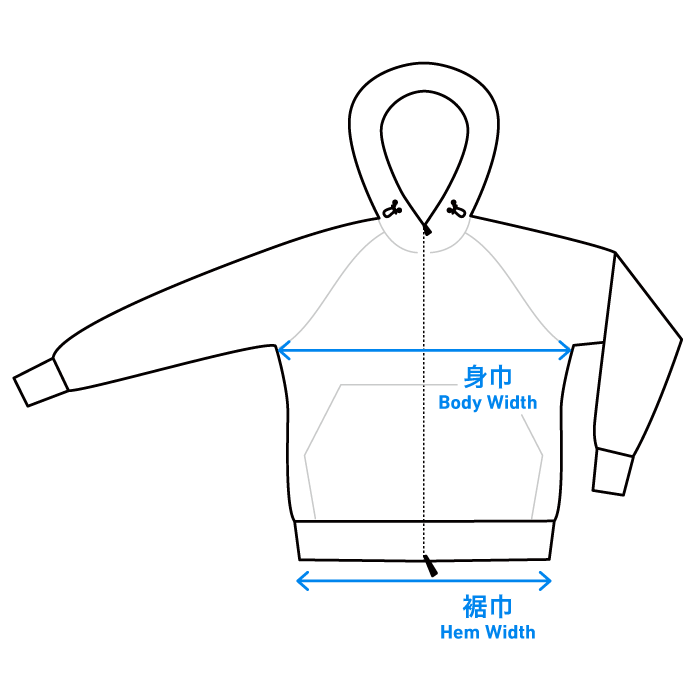
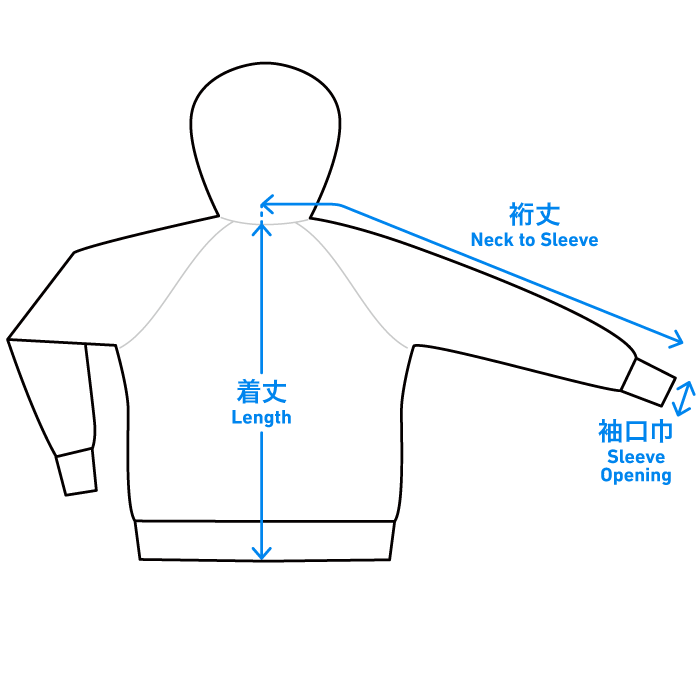
Unit:cm
| Size | XS | S | M | L | XL |
|---|---|---|---|---|---|
| Length | 66.5 | 70 | 73 | 75 | 77 |
| Body Width | 47.5 | 52.5 | 55 | 59 | 63 |
| Hem Width | 37.5 | 41.5 | 43.5 | 47 | 51.5 |
| Neck to Sleeve | 74.5 | 80.5 | 83 | 86 | 89 |
| Sleeve Opening | 8 | 8.5 | 9 | 9.5 | 10 |
The above sizes are the measurements when the product is brand new and unwashed. It will shrink about 1.5cm vertically and 1cm horizontally after a few washes.
Notes:
– Due to the elasticity of the fabric, there may be some individual differences in the size of the product.
– Due to the nature of the material, there may be some individual differences in the shrinkage. The extent of the shrinkage may vary depending on the type of washing machine or the machine settings.
– Using a dryer with a low-temperature setting may cause the garment to shrink more than when dried naturally. It will be restored after it is washed again and flat-dried.
– To reduce shrinkage after the wash, gently spread the shirt and iron it.

Our 100% Merino and 100% Merino Light products have wide-fit, standard-fit, and slim-fit: The 100% Merino Zip Hoody is standard-fit.
Fitting
Instructions
Hydrophilic 100% Merino
While normal merino wool fabrics are water-repellent finished at the manufacturing stage, our 100% Merino has a hydrophilic finish for better wicking performance.
However, the yarn is waxed to improve knitting efficiency during the mass-production process, which may not be fully removed by washing in the final processing stage, and the remaining wax may repel water, hindering the fabric’s absorption.
For better wicking of the fabric, please wash two or three times to remove the residual wax.
When the 100% Merino Light item in Blue, Mustard, or Navy is in contact with a white or light-colored shirt wet from rain or sweat, color may transfer and stain the shirt.
Tumble-drying
This product is tumble-dried with a low-temperature setting (60 degrees Celcius or lower). Please note that the dryer should be used only when it is necessary to prolong the lifetime of the garment.
Care Instructions
Care Guide
Please visit ourCare Guideon the 100% Merino Series for more information.
Washing
It is machine-washable, but please be careful with water temperature and machine settings as high temperatures may cause shrinkage. Because natural merino wool has short fibers, fuzz and pilling may appear, but after several washes, they will become less noticeable.
- Use a neutral detergent. Wool fibers are chiefly composed of animal proteins that are vulnerable to alkalinity, so avoid washing with alkaline detergent as it may damage the texture.
- Close the zippers, if any, to avoid the damage caused by the contact with metal parts.
- To avoid damage caused by contact with other laundry, or deformation caused by tangling, please wash it separately or use a laundry net.
- Please wash it separately from white or light-colored clothing to avoid a color transfer.
- Set your washing machine to “Gentle Course” or “Hand Wash Course” with gentle water flow. This will shorten the stressful process of wringing and dewatering, and minimize the risk of shrinkage and deformation.
- Washing with lukewarm water (about 30℃) will help remove dirt even with gentle water flow. Do not wash in hot water as high temperatures may cause shrinkage.
- Do not use fabric softener as it may coat the fibers and hinder the natural properties of wool.
- Do not bleach as it may cause color fading.
- Smooth out the wrinkles, adjust the shape, and dry flat in the shade. Line dry is not recommended as the wet fabric may be stretched by its own weight.
- Washing may cause slight deformation or distortion due to the nature of the fabric.
Precautions when using the dryer
The dryer can be used at a low-temperature setting (60℃ or lower). Please note, however, that repeated use of the dryer can damage the product. it is recommended to use the dryer only when necessary to prolong the product life.
How to Remove Wrinkles
Knitted fabrics are less likely to wrinkle than woven ones, but if the wrinkles are noticeable, please iron the product. There is, however, a risk of fabric shrinkage if the fabric is continuously exposed to iron steam at an excessively high temperature. Please follow the precautions below when ironing.
- Use a steam iron.
- Always use the iron at a medium temperature (around 140°C to 160°C) setting or lower.
- Avoid applying pressure. Let the steam blow over the fabric while slightly lifting the iron. Gently stretch the fabric while ironing for the best results.
- After applying steam for a few seconds, gently smooth out the wrinkles with your hands.
- If the wrinkles are still noticeable, apply a thin cloth and softly iron the fabric.
- After ironing, dry completely.
Keep in Shape
Shrunk or deformed clothes can be restored by ironing them. However, there is a risk of fabric damage and shrinkage if the fabric is continuously exposed to high temperatures.
- Do not strongly press the iron. Lightly iron with steam.
- Always use the iron at a medium temperature (around 140°C to 160°C) setting or lower.
- Avoid applying pressure, and let the steam blow over the fabric while slightly lifting the iron. If there is still any shrinkage, apply steam while stretching out the fabric.
- After blowing steam for a few seconds, stretch the fabric little by little while it is still moist by the steam to touch up the shape.
- After the shape adjustments, leave it for a while without moving it and dry well.
How to Avoid Insect Damage
Merino wool, an animal-derived fiber, has the disadvantage of being easily eaten by insects because of the protein contained in the fiber. However, the risk of insect damage can be reduced by proper care.
- If there is any dirt left, it can attract insects, so be sure to wash thoroughly before storing.
- Steam from an iron can effectively kill insects by heat. Use a medium temperature setting when ironing, and after steam, dry well before storing it.
- Keep well-ventilated. Avoid humid environments.
- Vacuum storage bags are also effective in preventing insect damage. Air left in the bag will allow insects to survive. Make sure to completely vacuum it and make it air-tight before storing. Please note that vacuum sealing may cause wrinkles.
- If you use mothballs, please follow the labelled instructions.
Payment
- We only accept payment by credit card. We currently do not accept payment via bank transfer from overseas accounts.
- We accept the following Credit Cards: Visa, Master, American Express, and JCB.
- To download your receipt, please click the link included in the Dispatch Notice, which we will send by email as soon as the items are dispatched.
- Bank transfer is only availble for those that own a Japanese bank account.
Delivery
- Order Confirmation will be sent after the order.
- The items will be dispatched within 3 days after the payment is confirmed.
- The dispatch notice will be sent by email as soon as the items are dispatched.
- The delivery may be delayed by unforeseeable reasons such as natural disasters and other logistics issues. We appreciate your patience and understanding.
- We cannot ship multiple orders in one package due to how our delivery system is currently set up.
- We will ship to regions in North America, Oceania, and Europe (excluding Russia) via DHL. For regions in Asia, the Middle East, Central and South America, Africa, and Russia, we use EMS (International Express Mail Service) for shipping.
- Shipping fees and delivery times vary depending on the shipping destination as well as the size and weight of the items.
Size Exchange
- Overseas customers who need to change the size of their order, should note that the time needed for shipping will vary greatly depending on your country of residence.
- We only accept exchanges when the item is unused (except for fitting).
- If you wish to exchange the size of the item, please contact us within seven days of receiving your order.
- Exchanges can only be made for the same color in a different size.
- If the size you wish is out of stock, we will suggest a different color.
- If the product is out of stock, we may simply have to ship the item back to you.
- All shipping costs to be carried by the customer.
- We will only send the exchanged item to you, upon receipt of return shipping cost via PayPal.
- Please be aware that some countries charge customs duties depending on the price of the item.
- We are unable to answer any questions on local customs. Please contact your local customs bureau.
Repair
A natural fiber, merino wool has wonderful properties such as excellent temperature and humidity control and deodorant performances, but it also has a weakness; yarns are likely to break and develop holes due to abusive use and moth eating.
For inquiries on repairing holes or products damaged over time, please feel free to contact us from the “Repair” section of the SUPPORT page.
Needle Felting
Holes in merino wool cut-and-sewn products caused by thread breakage or moth bites can be repaired by felting, a technique to patch the hole with the raw wool using a special needle. You can repair by yourself, and Yamatomichi also offers felting repair services using raw wool of the same color as the product.
For more details of felting and how we repair the merino items, visit Yamatomichi JOURNALS “#1 Repairing Holes in Merino Wool“.







